Welcome to my full review of Serpstat – a top-tier SEO tool that can match heavy-hitters like Semrush and Ahrefs.
To help you decide if it’s the right SEO tool for you, we’ll talk about stuff like:
- How to use Serpstat
- Its pros and cons
- How much it costs
- Who should use it
- Other alternatives
Let’s get started.
Table Of Contents
- 1. What is Serpstat?
- 2. A quick tour of the Serpstat interface
- 3. Getting Started with Serpstat
- 4. Running a site audit
- 5. Tracking your target keywords
- 6. Leveling up your SEO with domain analysis
- 7. Analyzing your competitor’s backlink profile
- 8. Spying on your competitor’s content
- 9. Looking for profitable keyword ideas with Serpstat
- 10. Making the most out of Serpstat: Other helpful tools
- 11. Serpstat Pricing
- 12. Serpstat Frequently Asked Questions
- 13. Conclusion
Note: You can use the coupon code “MasterBlogging” to get an exclusive 25 percent discount on any Serpstat plan. Click here for more information.
What is Serpstat?
Serpstat is an all-in-one SEO tool designed for keyword research, domain analysis, backlink analysis, rank tracking, and more. It can also be used to manage PPC campaigns as well as generate white-label reports for agencies.

As you probably know by now, I’m a huge fan of tools that can help bloggers elevate their careers.
Serpstat is no exception.
It has everything you need to concoct SEO strategies that get results.
I’m talking about features like advanced keyword research, competitor backlink analysis, rank tracking, site auditing, and in-depth domain analysis.
My favorite aspect is, of course, how easy it is to do those things with Serpstat.
Let me elaborate.
A quick tour of the Serpstat user interface
I must say, Serpstat’s user interface is among my absolute favorites.
Not only is the dashboard clean and easy to navigate, it also works fast.
Upon logging in to your account, you’re immediately taken to the “My projects” page.
This is where you can get a quick glance at important aspects of your SEO, including your:
- Organic keywords
- Paid keywords
- Backlink analysis
- Tracked keywords
- Site audit data
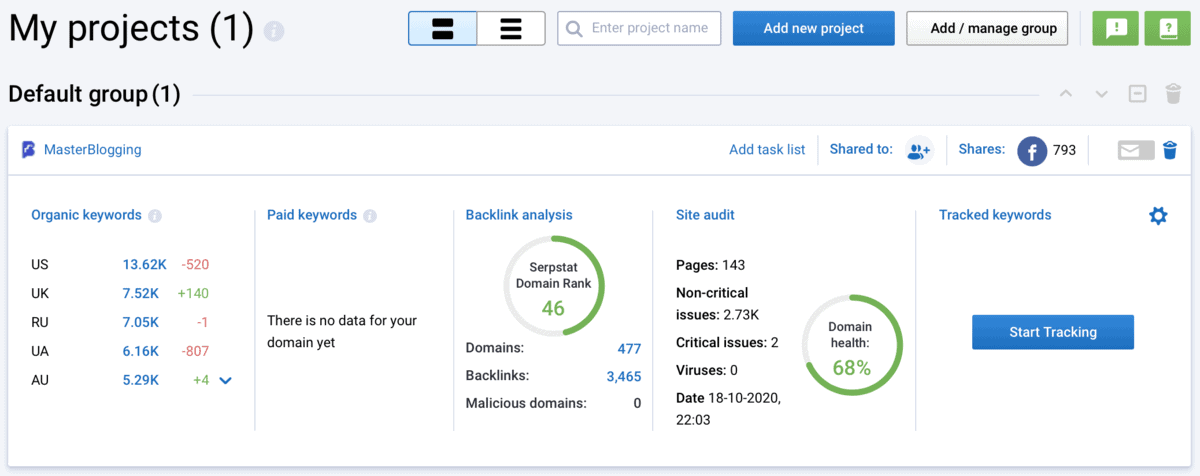
To the left, you’ll find everything there is to see on the platform.
We’ll go over each of these pages in a few minutes. For now, just appreciate how Serpstat makes it easy to find the tools and features you need.

Getting Started with Serpstat: Creating Your First Project
If you’re new to Serpstat, the first thing you should do is set up your first project.
You can do this by clicking ‘Add new project’ on the “My projects” page.
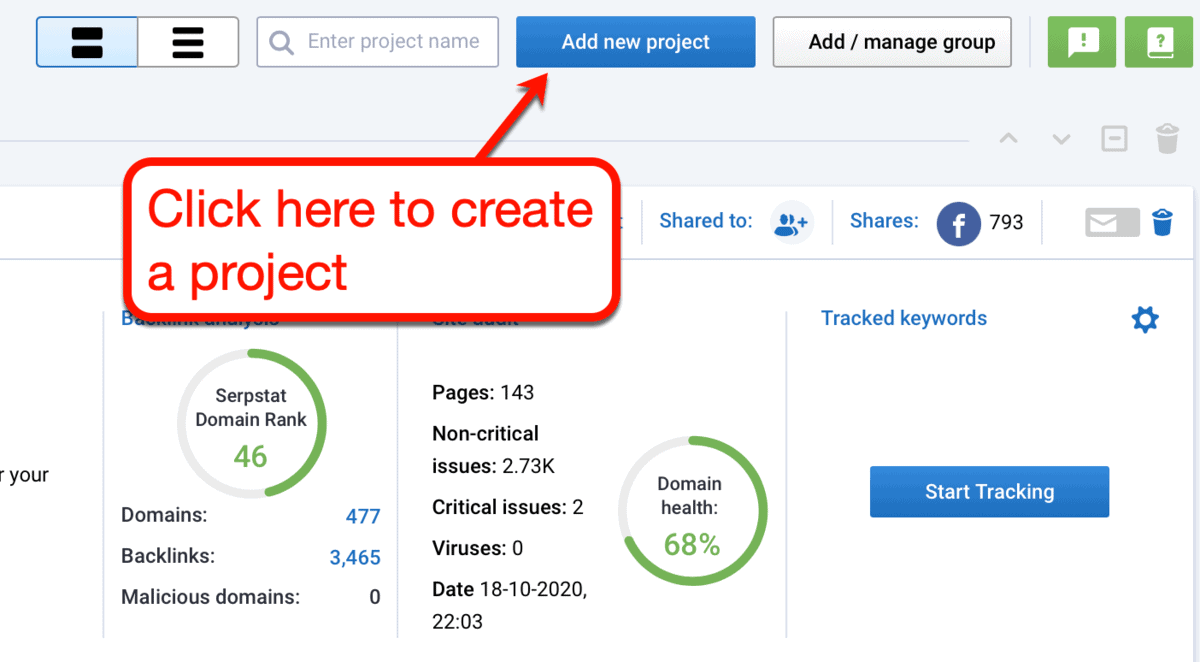
This will pull up the “Create project” window where you can enter basic details about your project.
Simply specify your domain, project name, and project group. Once done, click ‘Create’ to proceed.
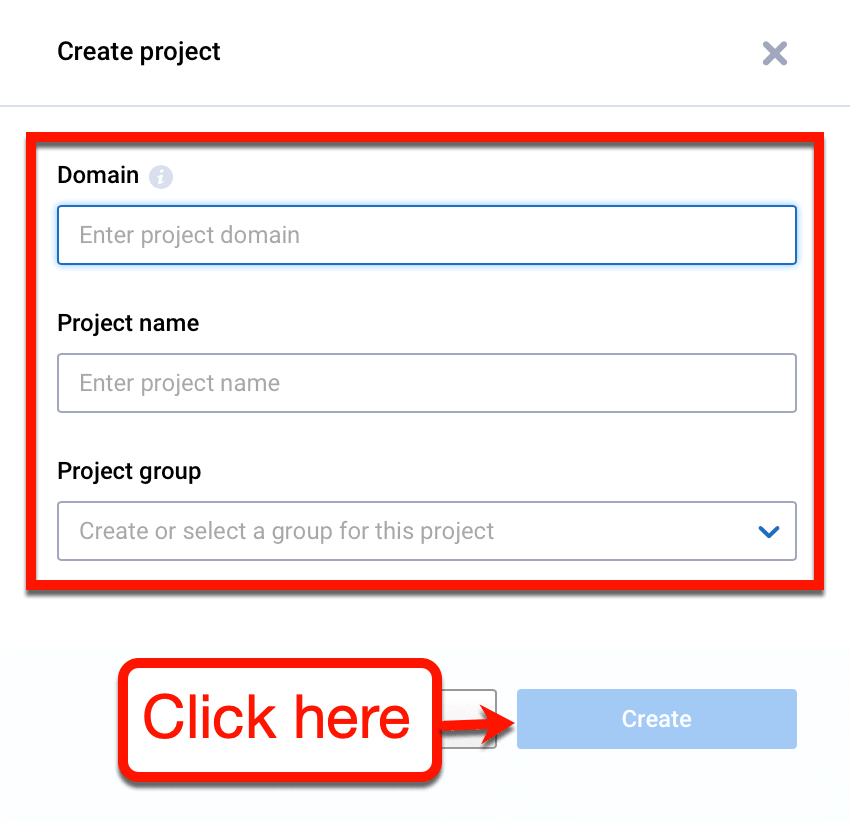
If you haven’t created a project group yet, create a new one by simply typing in a name. Otherwise, new projects will be added to the first group you created.
When done, your website should now appear on your “My projects” page under the group you specified.

As you can see, Serpstat already worked its magic by providing basic SEO information. This includes your keywords and backlink profile analysis.
If you want to dig deeper, click on the header link for any data section.
For example, if you want to check your organic keywords, just click ‘Organic keywords’ and Serpstat will show you more.

Like what you see?
Don’t worry – we’ll take a much closer look at Serpstat’s keyword research capabilities later.
For now, let’s head back to your project.
The next thing I’d do is run a site audit to make sure your website is in tip-top shape.
Remember, domain SEO audits can take a lot of time. That’s why it’s better to do it sooner rather than later.
To run a site audit, click ‘Start Audit’ next to the backlink analysis section.
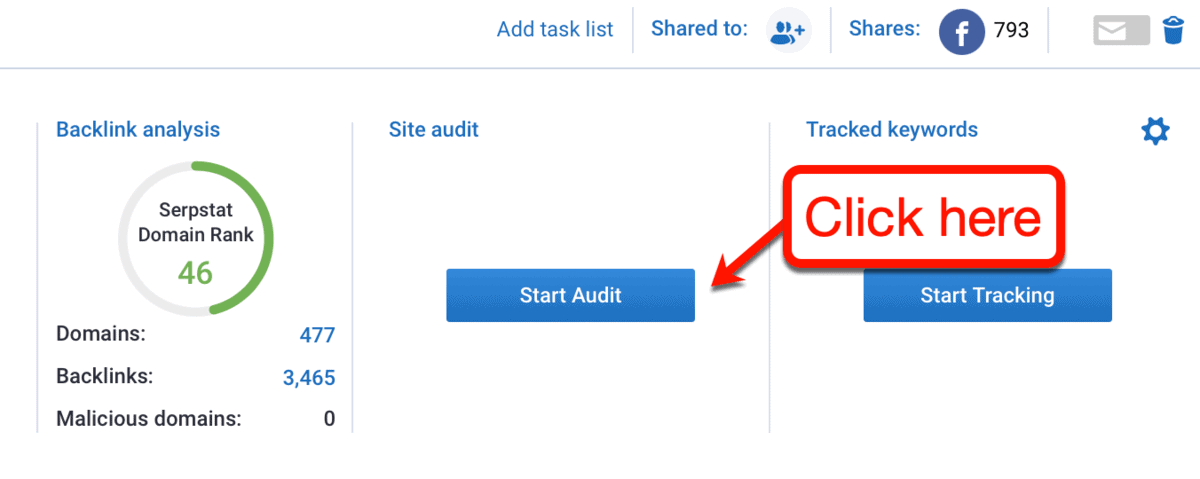
Running a site audit
Before running an audit, you need to configure your settings first.
From the main tab, you’ll see the names of your domain and project – nothing you didn’t already know.
You can also set whether or not you’d like to check your website’s subdomains. To get a more thorough report, I suggest leaving this option selected.
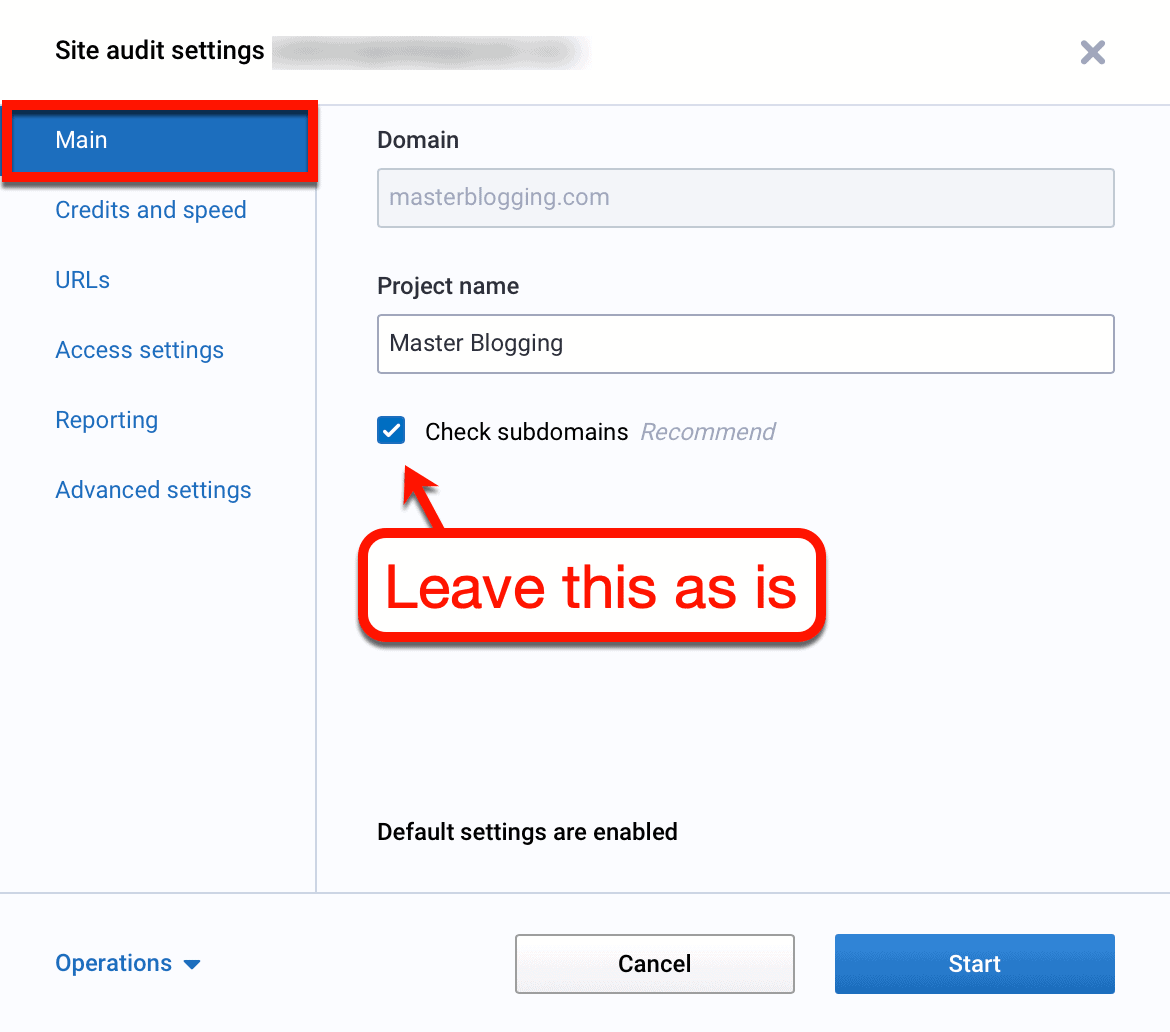
Configuring scanning speed
On the “Credits and speed” tab, you can configure how fast and extensive the audit will go.
Take note that running an audit with Serpstat can temporarily affect your website’s performance. After all, it basically runs a script on thousands of pages on your website to check for SEO-related issues.
That said, Serpstat allows you to manually adjust the scanning speed of the audit. The faster the scanning speed, the more the audit can bog down performance.
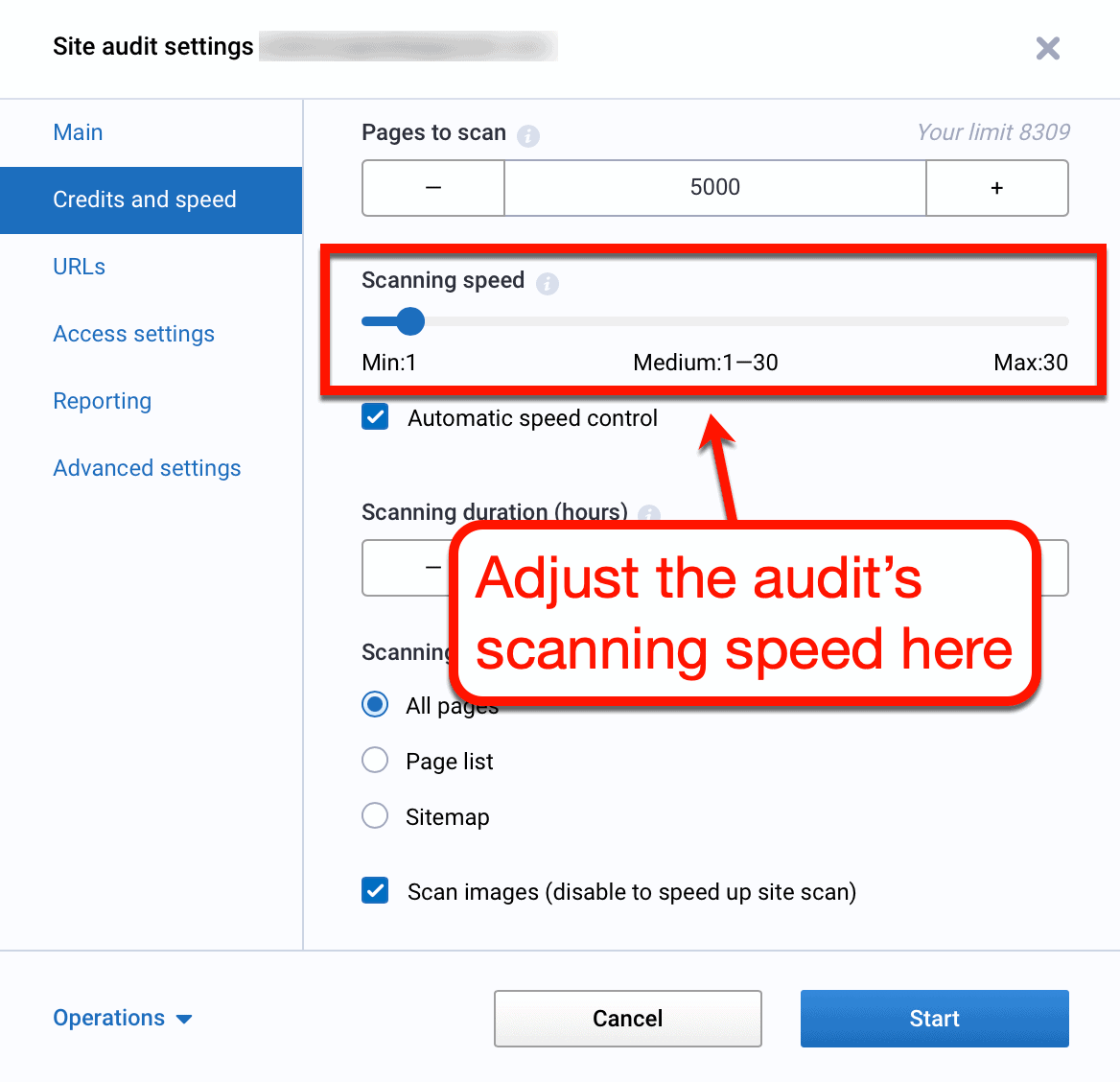
You can also select ‘Automatic speed control’ to allow Serpstat to automatically determine the optimal scanning speed for your site.
This will ensure the audit runs at an efficient rate while preventing any noticeable dips in your website’s performance.
Other than the scanning speed, you can also fine-tune the following settings from the “Credits and speed” tab:
- Pages to scan – Set the total number of pages you want to include in your audit.
- Scanning duration – Set the maximum duration of the audit.
- Scanning type – Set Serpstat to scan all pages, a list of pages, or pages in a sitemap.
- Scan images – Include or exclude images in your audit.

For new and small blogs, you can ramp up the scanning speed as you see fit.
But if you have an old blog with tons of content, I recommend using the automatic speed control. This will make sure the audit won’t affect the experience of your current readers.
Specifying URL settings
On the “URLs” tab, you can set additional rules that tell Serpstat what (and what not) to scan.

Here are the URL settings you can modify:
- Max folder depth – Set the maximum number of folders or directories in the URL of pages to be scanned. For example, with a max folder depth of two, a page with the URL “www.yoursite.com/folder1/folder2/folder3/yourpost.html” won’t be included.
- Max scan depth – Set the maximum number of clicks it would take to reach the pages that will be scanned. With a scan depth of 10, only pages within 10 clicks from your homepage will be scanned.
- Don’t scan pages – Specify words in the URL of pages that won’t be scanned. If the URL of a page contains a specified word, it won’t be included in the audit.
- Scan only pages – Specify words in the URL of the only pages that will be scanned. This does the exact opposite of what the previous setting does.
- Scan pages closed from indexing – Choose whether or not pages that are excluded from indexing should be scanned.This can be done automatically through various tools or manually using the “noindex” meta tag.
- Scan non-canonical pages – In simple terms, a canonical page is the preferred version of a page on a website. Non-canonical pages are duplicates or different variations of an existing page that search engines won’t index.
Setting up access settings
Still in the early stages of web development?
Some website owners like to password-protect pages that are under construction. If you did this with your entire website (or just some of its pages), site auditing may be unavailable.
That is, of course, if you provide the site audit tool with the proper access settings.
On Serpstat, you can do this on the “Access settings” tab of the site audit settings window.
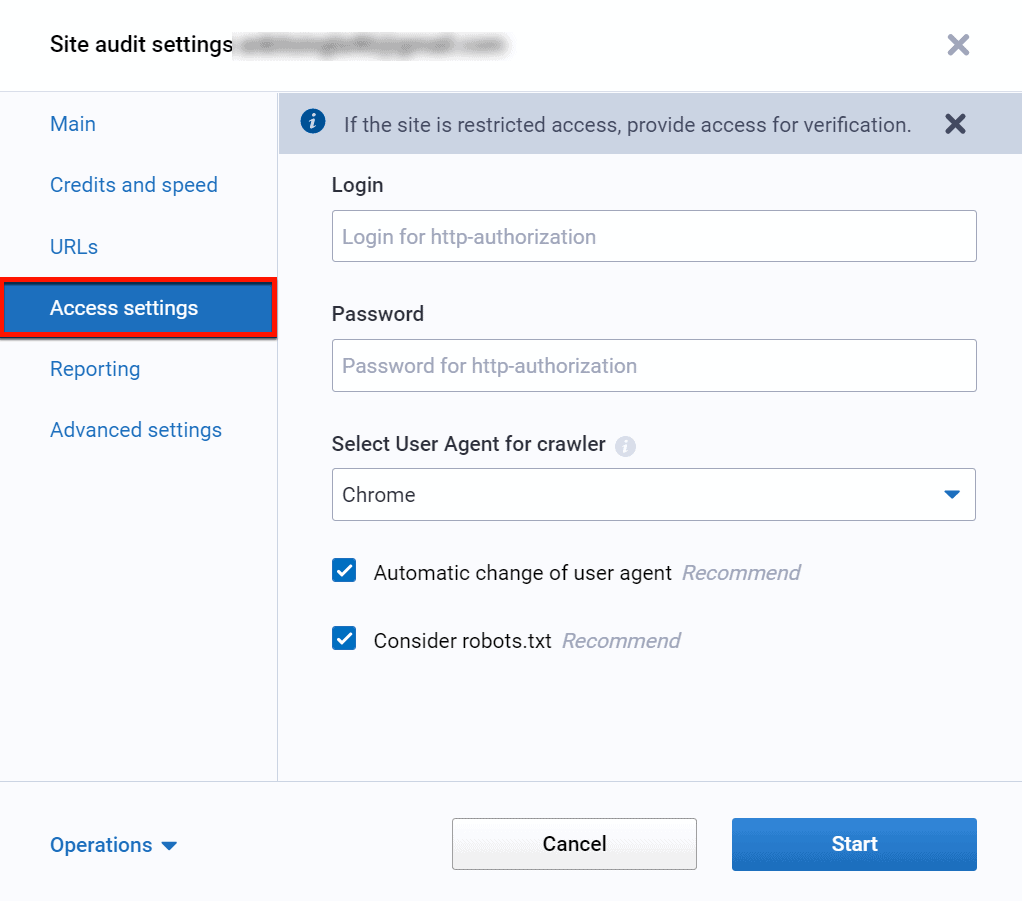
The input fields you can see here should be rather self-explanatory.
Just input the login credentials, preferred “User Agent,” and you’re good to go. There’s no need to change the rest of the recommended settings at this point.
Setting up reports
To get notified once the site audit is complete, you can set up email reports from the “Reporting” tab.
All you have to do here is enter the email you want to receive the reports with. You can also set the schedule and frequency of reports.
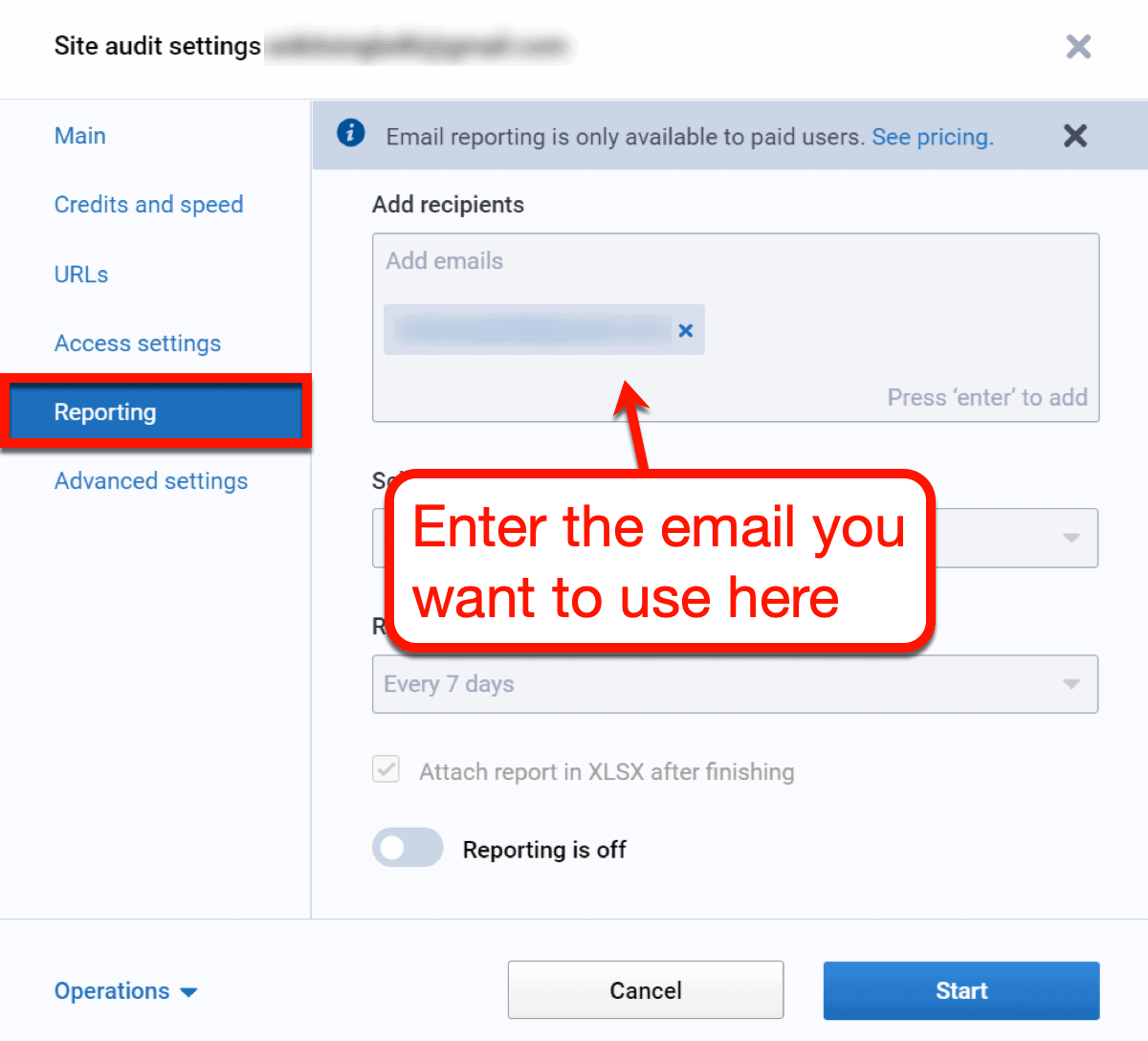
Tweaking advanced settings
Serpstat’s site audit tool works by detecting crucial on-page SEO issues on your website.
On the “Advanced settings” tab, you can fine-tune parameters like your preferred title length range, external link limit, and more.
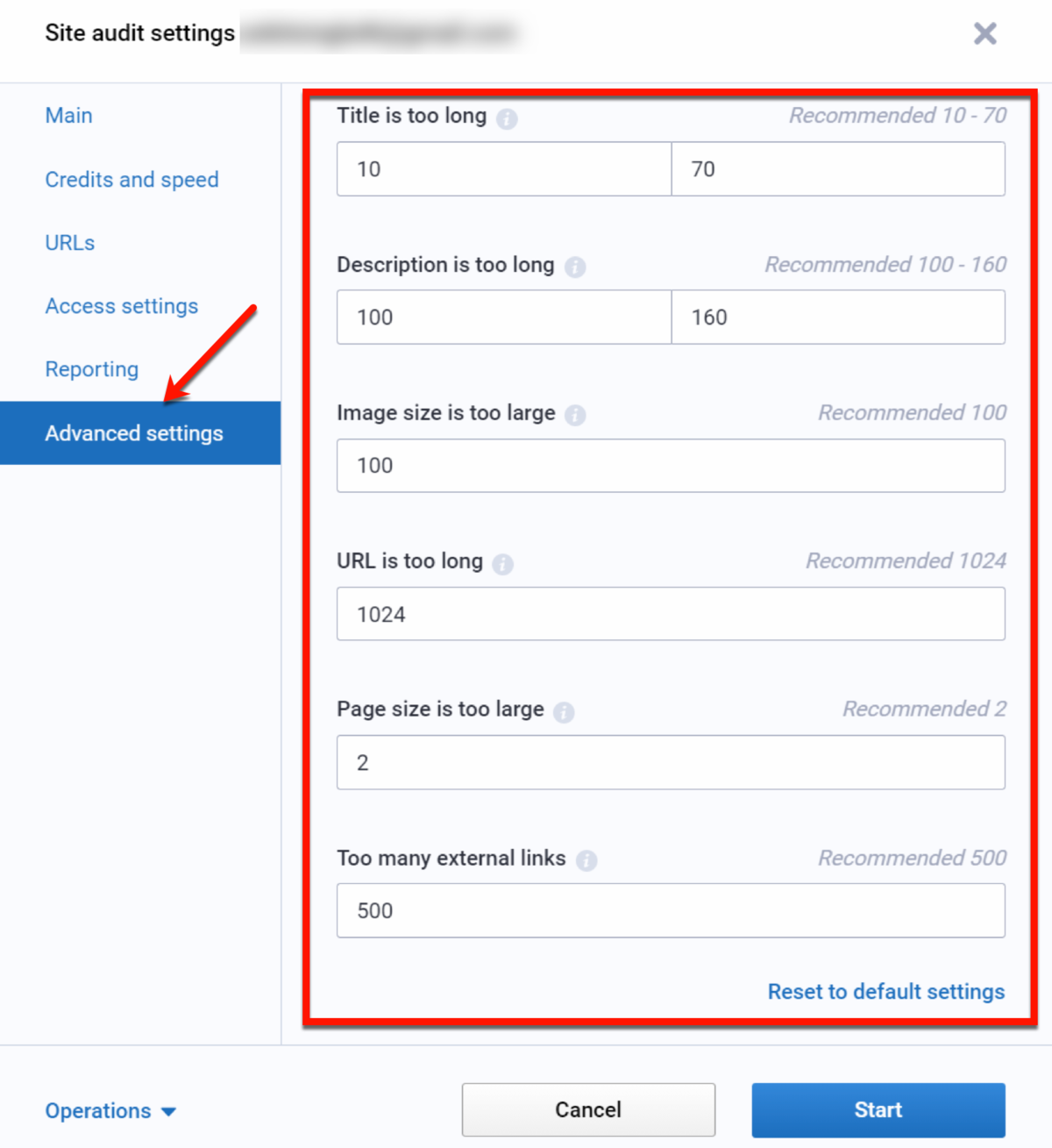
Not sure what values to use?
Here’s a tip: leave those numbers alone.
There’s really no need for you to change the recommended values unless you’re already a highly experienced SEO practitioner.
Personally, the only thing I’d change is the image size threshold.
As you can probably tell, I use a lot of high-resolution screenshots when creating in-depth guides. Even after using image compression, the size of my blog images still ranges anywhere between 400 and 1,000 kilobytes.

After finalizing the settings of your site audit, click ‘Start.’
Serpstat will show you a live update of the audit process.

A full site audit can take a few minutes up to a couple of days. This depends on how big your site is.
As for my website, the audit report was generated after several hours.
Reading the audit results
You can take a peek at the audit results by going to your “My projects” page.
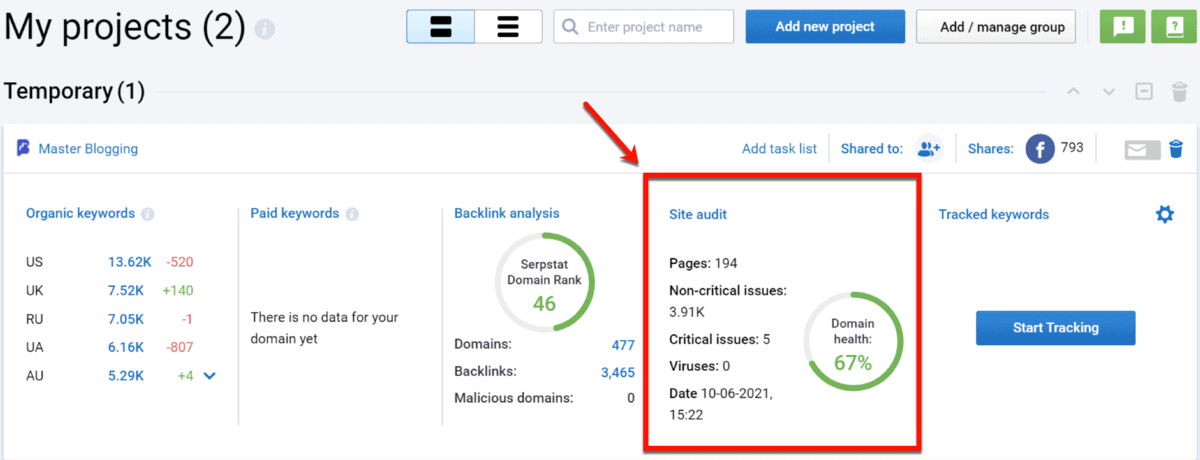
From there, you can see an overview of your website’s health.
The first thing you’ll probably notice is your “Domain health” rating. But you don’t need to worry about that right now – hopefully, that number only goes up over time.
What you need to look at are the critical and non-critical issues that demand your attention.
To inspect these issues, click ‘All issues’ from the “Site audit” sub-menu.

Serpstat will then present you with a list of all issues on your website that can affect your rankings.
At first, issues are grouped according to categories like “HTTPS Status Code,” “Headings,” “Multimedia,” and “Accessibility & Indexation.”

You can also comb through these issues by picking a priority, which is the most reasonable thing to do.
Keep in mind that certain issues have a bigger impact on your website’s rankings.
A 404 status code, for instance, indicates a broken link. This is bad not just for your website’s rank-worthiness, but also for the experience of readers.
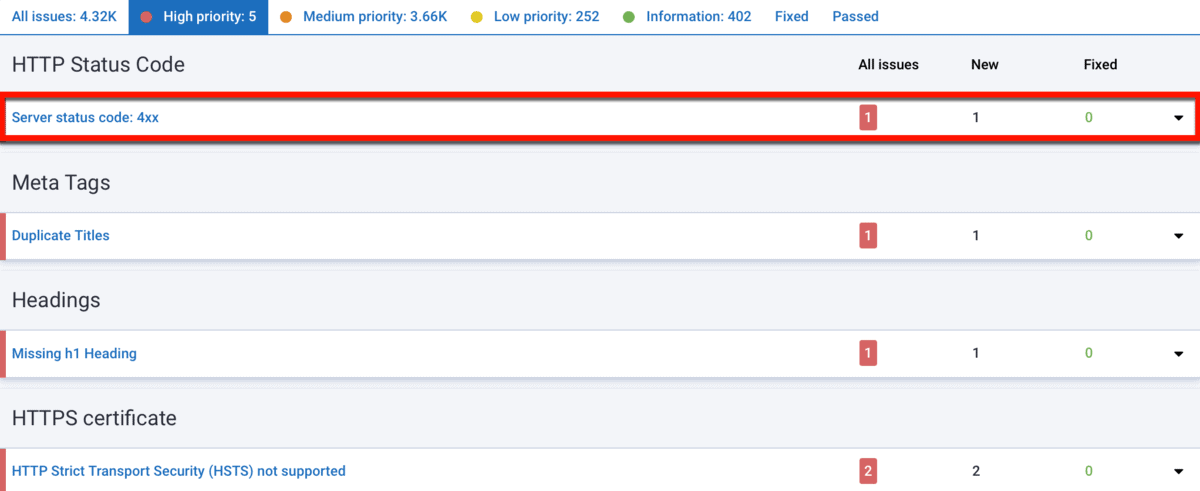
If you’d like an overview of the audit results, simply head to ‘Audit summary’ from the menu.
Here, you’ll find a log of the audit process along with an overview of all detected issues.
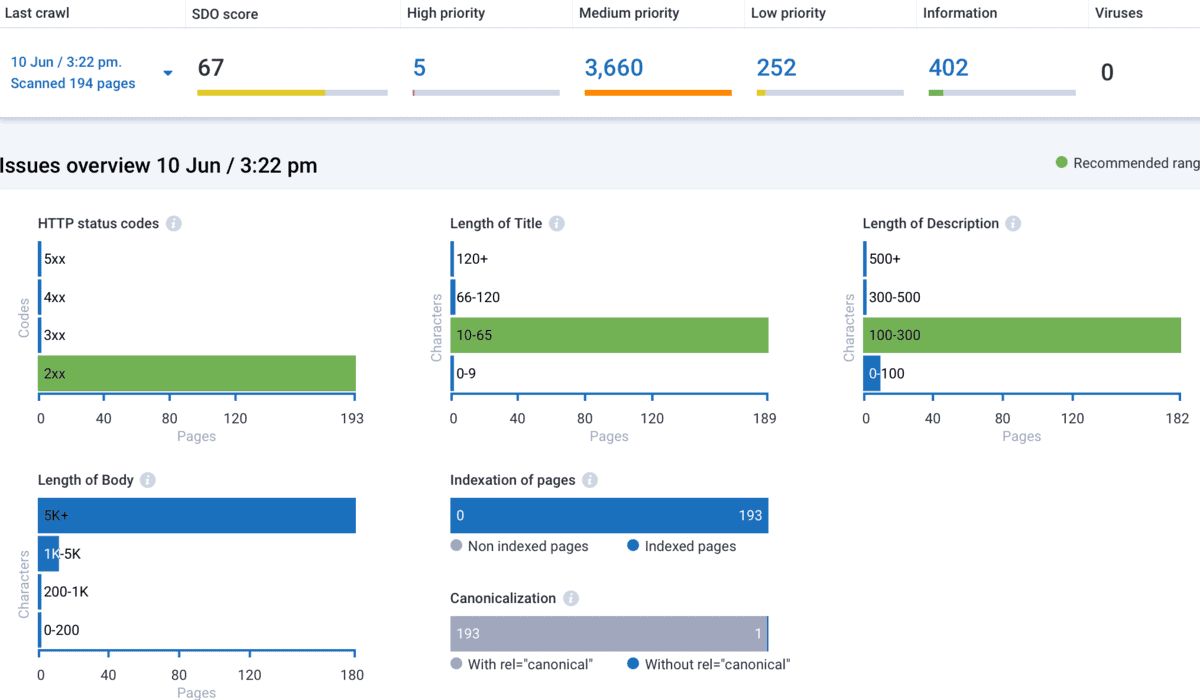
If you ask me, Serpstat’s site audit tool is one of its most impressive features.
Reports are incredibly thorough and detailed. And despite having heaps of data, everything is readable and easy to find.
Just remember that you can run an audit on an individual page using Serpstat’s “Page audit” feature. This will allow you to track the search engine optimization of your money pages over time.
Tracking your target keywords
Great – you’re done with the first half of setting up your first Serpstat project.
The next order of business is to set up the keyword tracker, which you can do from your projects page.
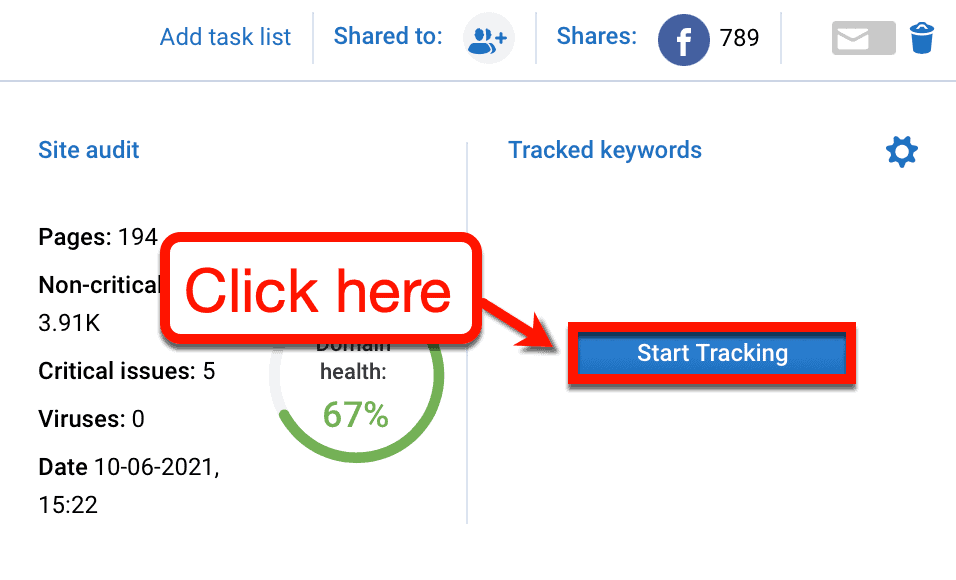
This tool allows you to track the search positions of your website, its mirrors, and your competitors.
First, enter the domain URLs of all the websites you want to include in the tracker.
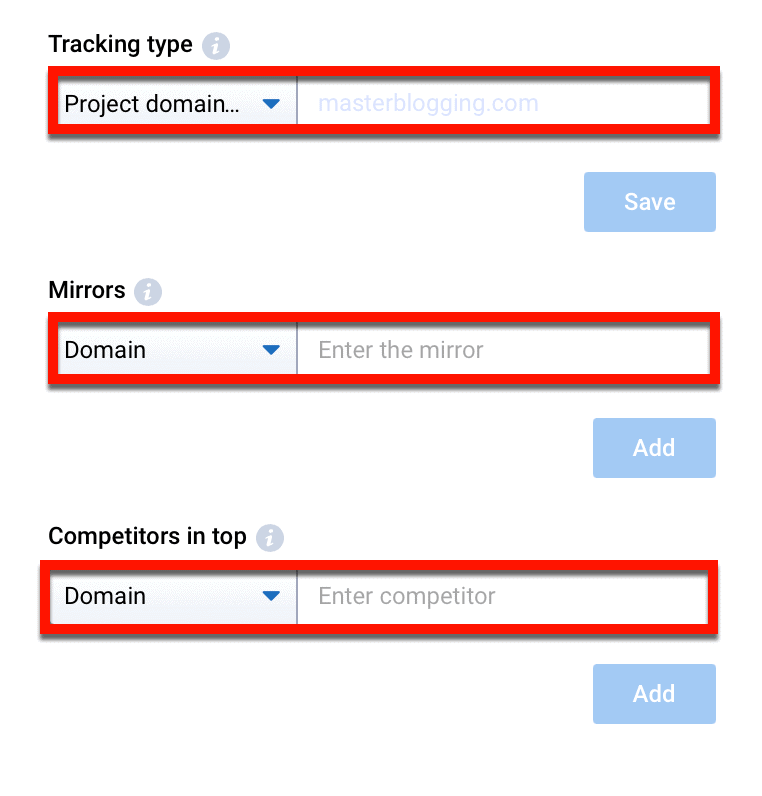
Once the domains are set, plan the schedule of your keyword tracker.
You can do this by clicking the pencil icon next to “Tracking frequency.”
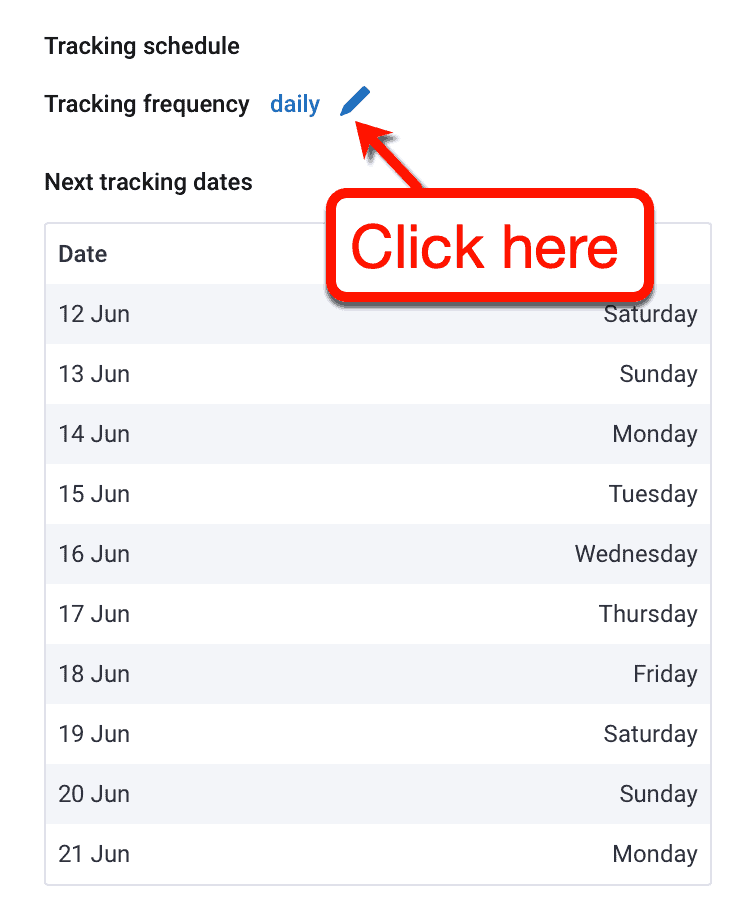
Setting the tracking frequency
You have three options when choosing the tracking frequency of this tool:
- Daily
- By days of the week
- By dates of the month
If you chose “By days of the week,” you need to manually select the tracking days. Just expand the “Select weekdays” drop-down menu and use the checkboxes to set the schedule.
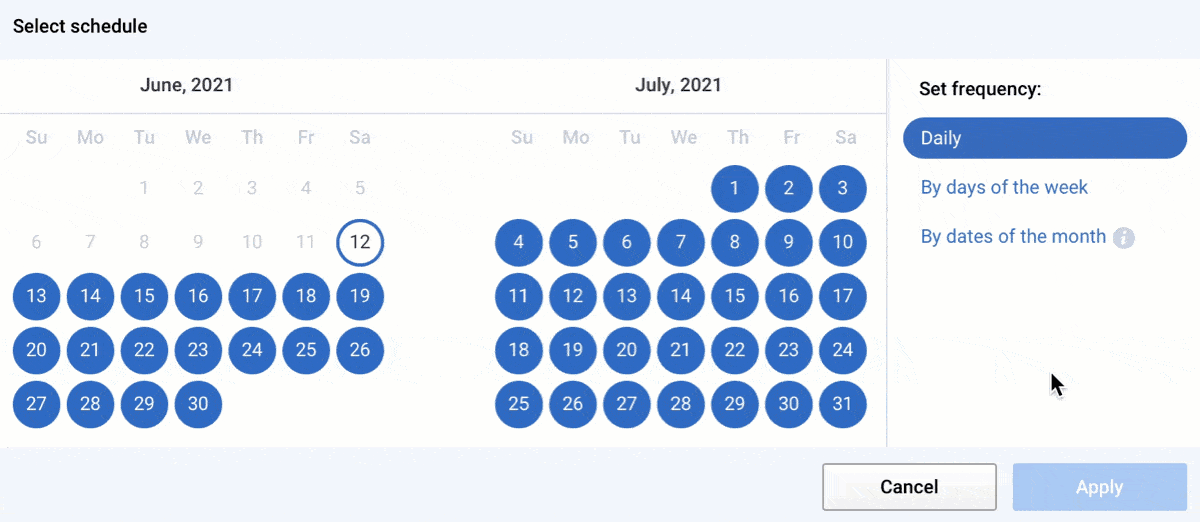
If you choose “By dates of the month,” all you have to do is type in the specific dates (1-31).

Specifying your search regions and devices
With your schedule set, the next step is to specify the search regions you want to track.
Switch to the “Search regions” tab to proceed.
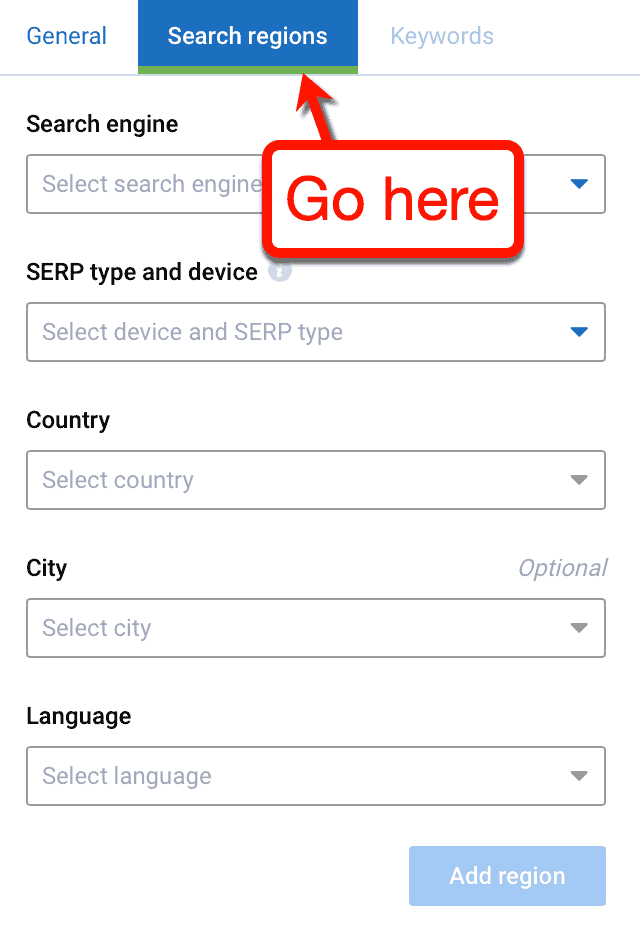
Feel free to configure these settings any way you please.
Certain settings, namely your country and language, must be accurate.
The preferred options for “Search engine” and “SERP type and device,” however, are as follows:

With these settings, Serpstat will monitor your organic keyword rankings on Google for both mobile and desktop devices.
If you’re running a PPC campaign, simply select “Mobile, paid” and “Desktop, paid” from the SERP type drop-down menu.

Importing your keywords
After adding your search regions, move over to the “Keywords” tab.
This is where you can enter or import your list of target keywords.
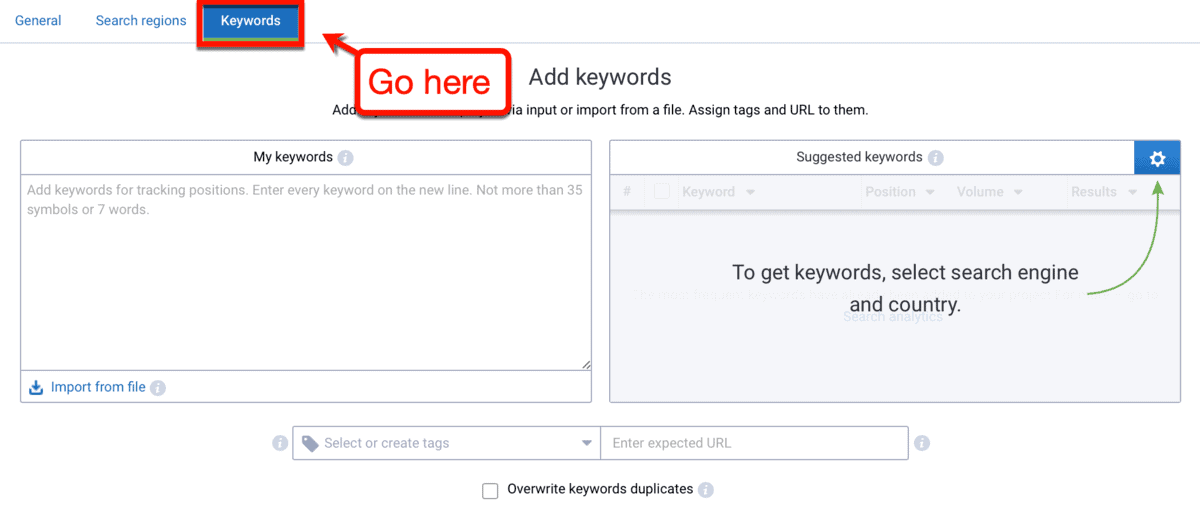
To get keyword suggestions, click the gear icon next to “Suggested keywords” and select another region.
Serpstat will automatically present you with keywords your website already ranks for.
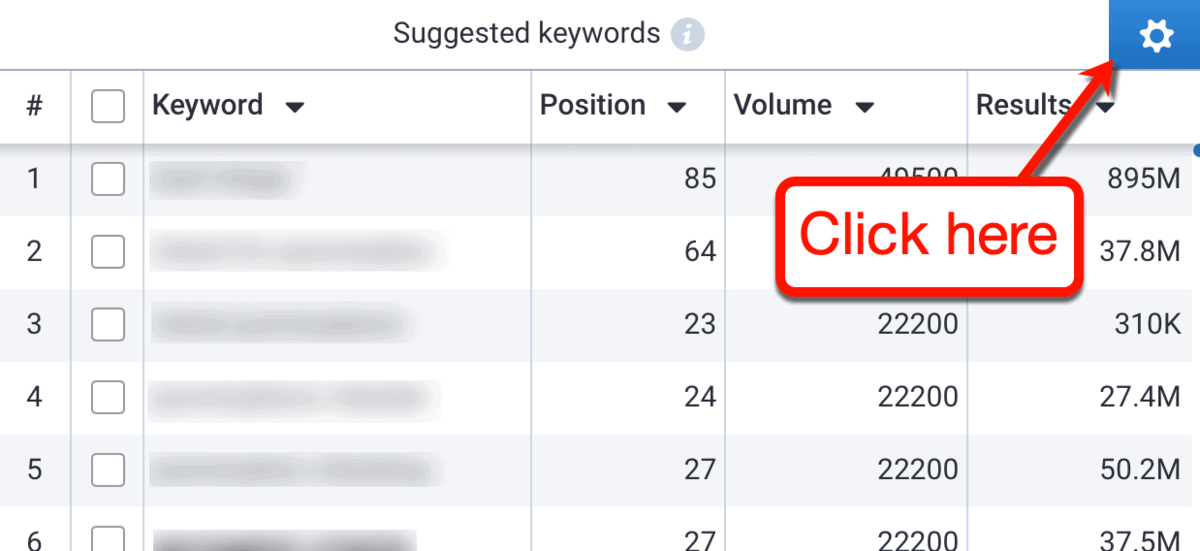
After adding keywords, you should now see them in the “Project keywords” table.
Here, you can enter the specific page you’re optimizing for each keyword. Just click ‘Enter expected URL’ and type in that page’s URL.
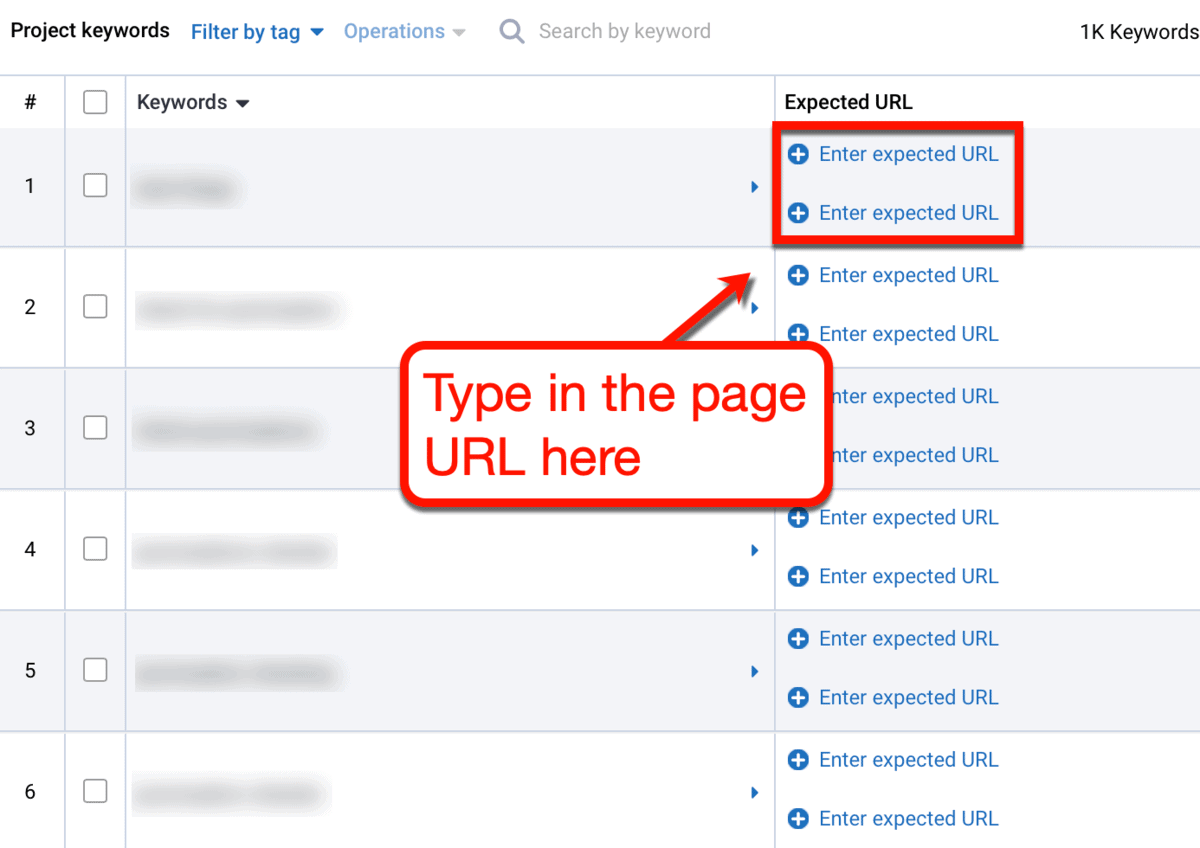
Checking out your keyword data
Additional keyword data can be found on the rank tracker keywords page.
To go there, expand ‘Rank tracker’ from the main menu and click ‘Keywords.’
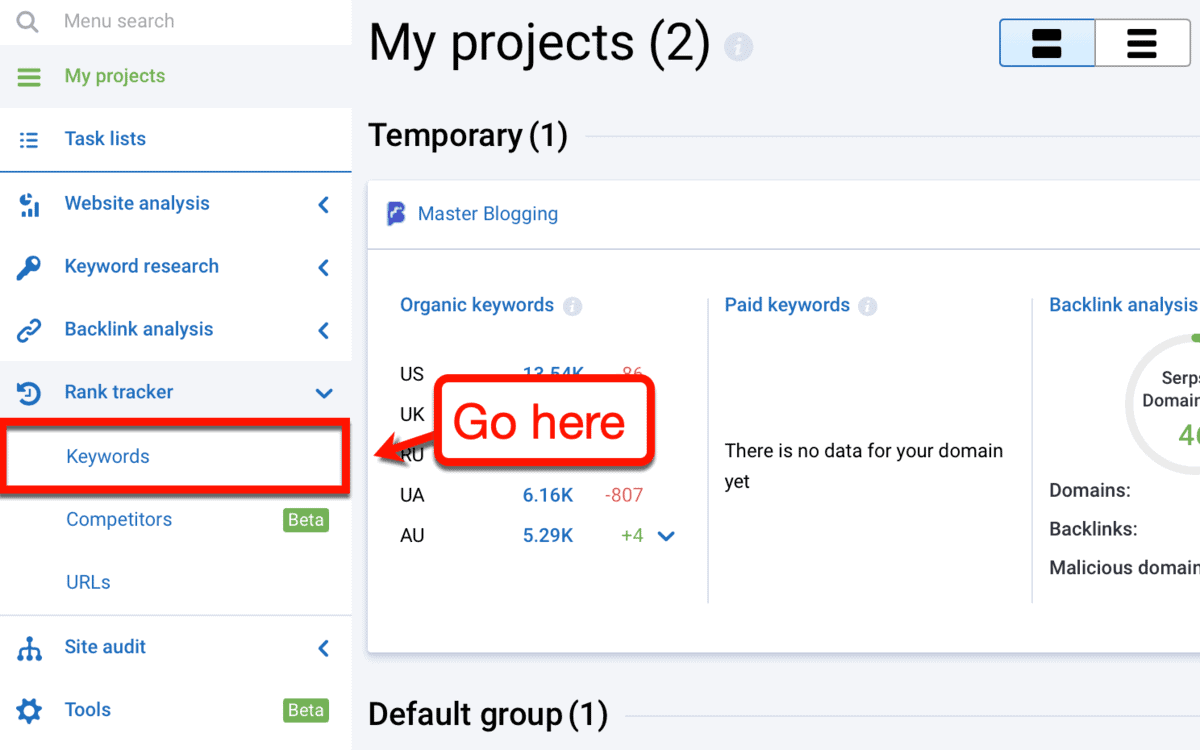
At the top, you’ll see information such as your domain’s visibility score for all keywords, average position, and keyword count. You can also find your keyword position ranges in the graph below.

Pretty cool, right?
At the bottom of the page is a list of your tracked keywords.
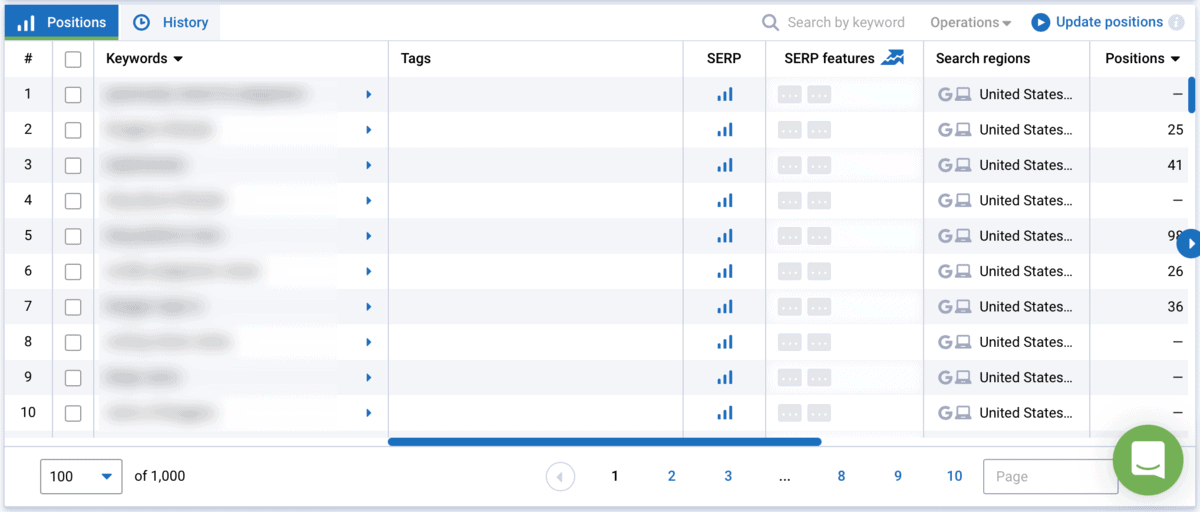
In addition to the keywords themselves, the list includes important keyword details and metrics.
This includes the keyword’s SERP features, search volume, your website’s positions, and so on.

Remember, we’re just looking at keywords from the rank tracker.
If you want to do some serious keyword research, you have to use Serpstat’s stack of keyword research tools.
We’ll get to that later.
For now, there are other ways to make sure your website is in great condition SEO-wise.
Allow me to introduce you to one of Serpstat’s key features – website analysis.
Leveling up your SEO with domain analysis
Upon creating your Serpstat project, you can initiate a domain analysis by clicking on your project’s name.
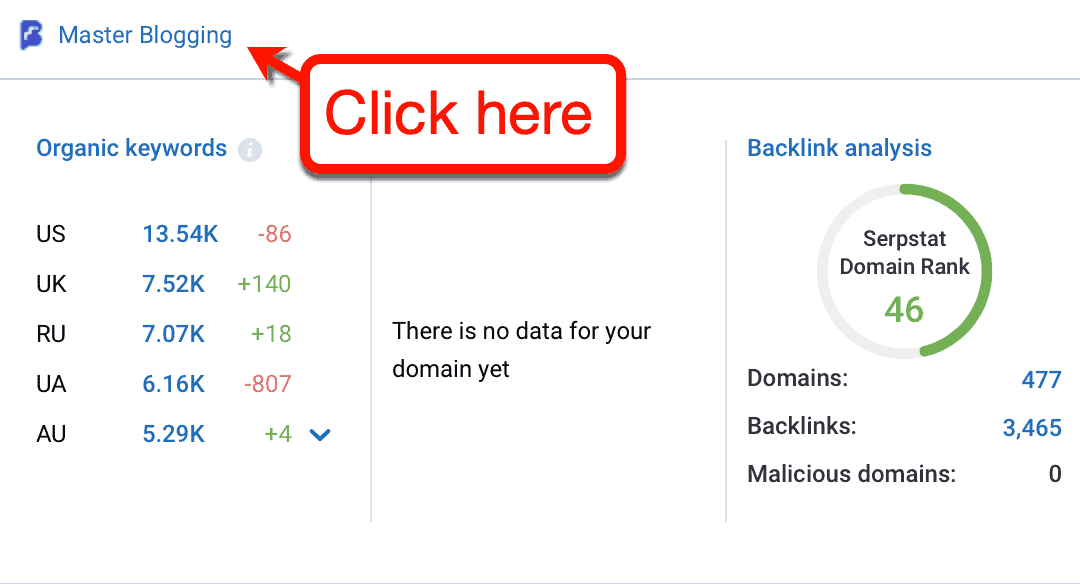
Another way to analyze your domain is to use the top search bar. You can also analyze other domains this way.
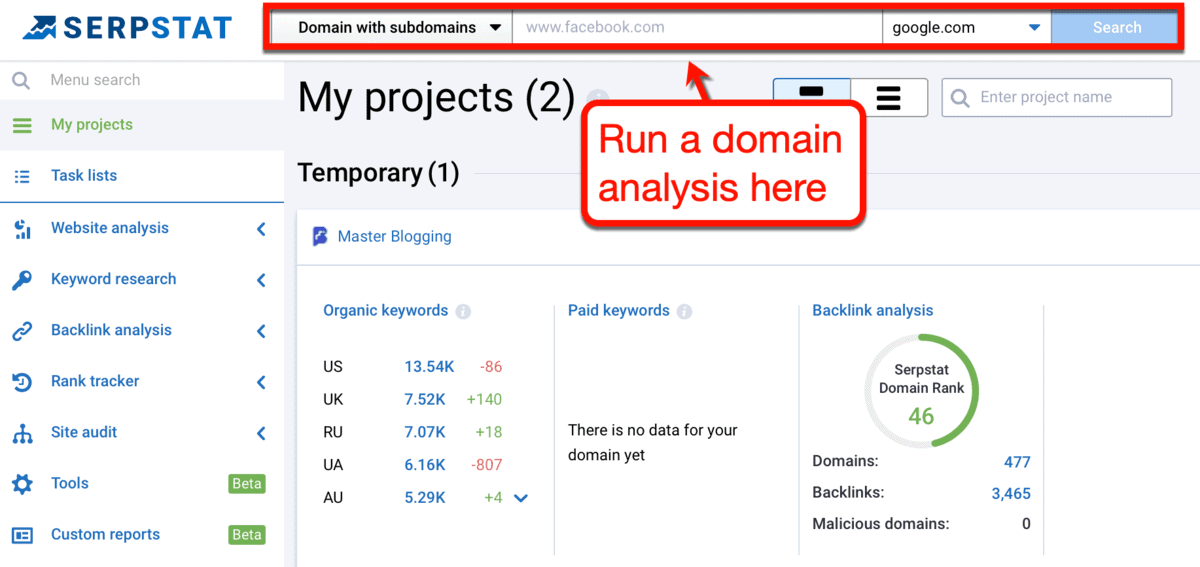
Now, let’s take a look at the domain analysis overview page.
Right off the top, you can see your website’s visibility score, estimated search traffic, and basic keyword data.
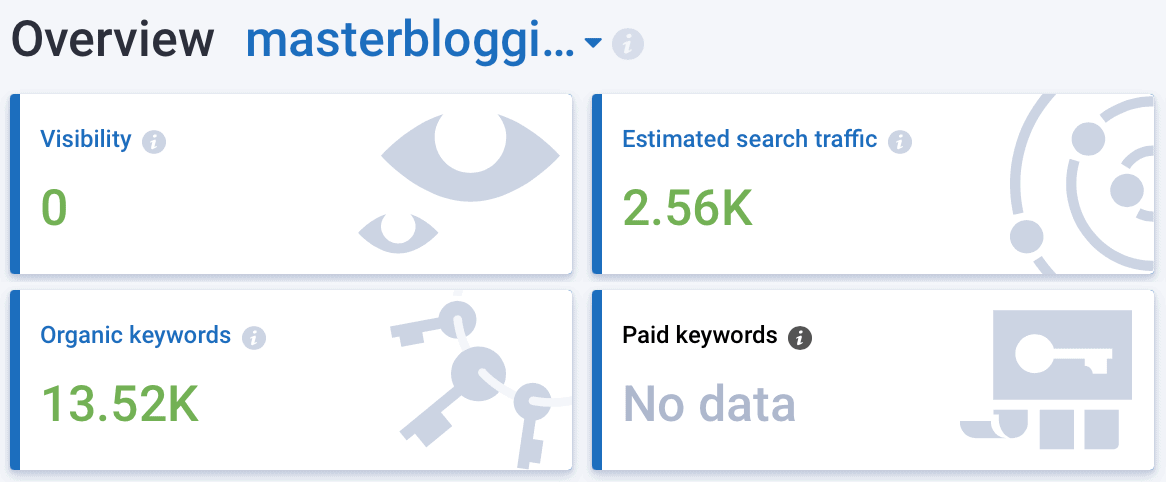
The overview page also unpacks a ton of other SEO and PPC information about the analyzed site.
One of the most important would be the “Top pages” section.
Identifying the top pages
If you’re analyzing your own domain, this allows you to identify your top-performing pages.

By inspecting the content on this list, you can determine your strengths as a blogger.
Ask yourself, what particular content types get me the most results? Do these posts share a similar content creation strategy that I can easily instill into other pages?
Observing your top pages will help you answer these questions.
Below the top pages list, you’ll see another list. Only this time, it is filled with competitors that Serpstat automatically identified for you.
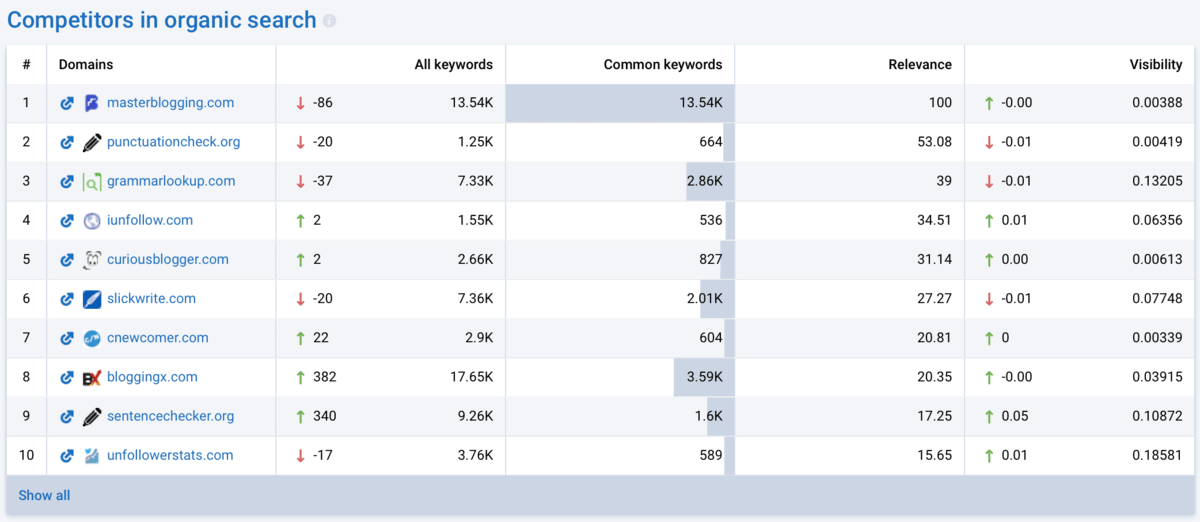
Next to each competitor are metrics that measure their keywords, shared keywords, relevance, and visibility. These details will let you know which among them are your fiercest competitors in terms of SEO.
Serpstat also visualizes the competition – making it even easier to find your closest competitors.
The nearer competitors are to your domain, the more you should watch out for them.

Of course, we’re just scratching the surface of Serpstat’s competitor analysis capabilities.
We’ll take a deeper dive later.
For now, let’s check out the rest of the domain analysis page.
Accessing PPC data
The next two sections are all about PPC.
If you don’t have a PPC campaign, these will be empty. Otherwise, you’ll see a list of your PPC competitors along with some ad examples from the analyzed domain.

A glance at the backlinks overview section
At the very bottom of the domain analysis overview, Serpstat will give you a quick backlinks report.
If you’re scanning your own domain, this will help you maintain a healthy link profile. But if you’re analyzing a competitor, this can lead you to juicy backlink opportunities.

You can take a closer look at the backlinks report by clicking the ‘Backlinks overview’ link.
This takes us to the next thing I want to cover in this review.
Analyzing your competitor’s backlink profile
Backlink analysis is a very important aspect of SEO.
Acquiring backlinks from authoritative sites will improve your rank-worthiness in Google’s eyes. However, you need to be careful when picking your link sources.
Tools like Serpstat can help you by revealing the backlink profile of your top competitors.
To do this, click ‘Backlink dashboard’ and type your competitor’s domain in the search bar.

Spying on your competitor’s backlinks
Imagine for a minute that you’re a big food blog and The Salty Marshmallow is your top competitor.
After entering their domain, Serpstat will start you off with an overview panel. This includes valuable metrics like their Serpstat Domain Rank, number of referring domains, and total number of backlinks.

This section alone should give you an idea of what you need to outrank them.
But the really good stuff can be found on the “Backlinks” page.
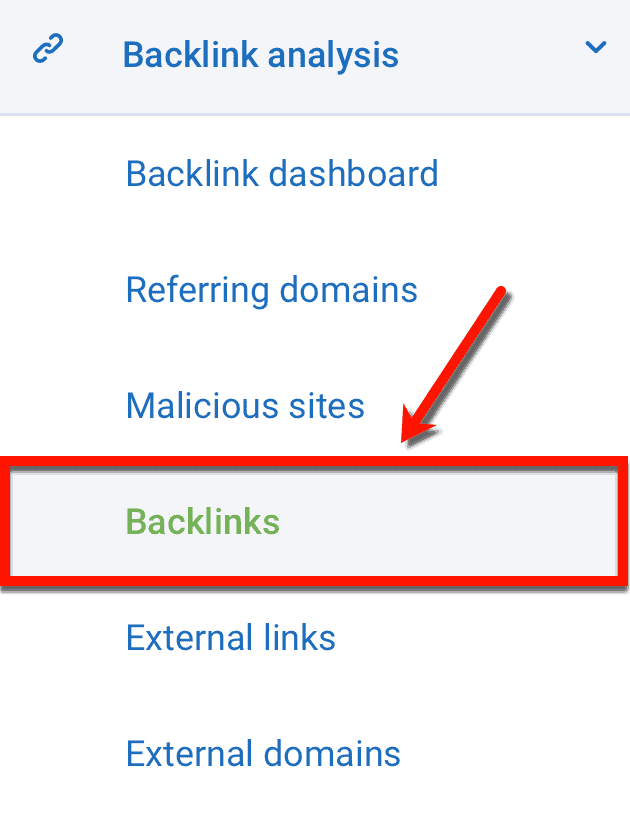
Here, you can track your competitor’s new and lost backlinks over the months.
Serpstat also provides a clear view of each backlink. You can easily find each link’s target page, type, the link source’s domain rank, and number of external links.
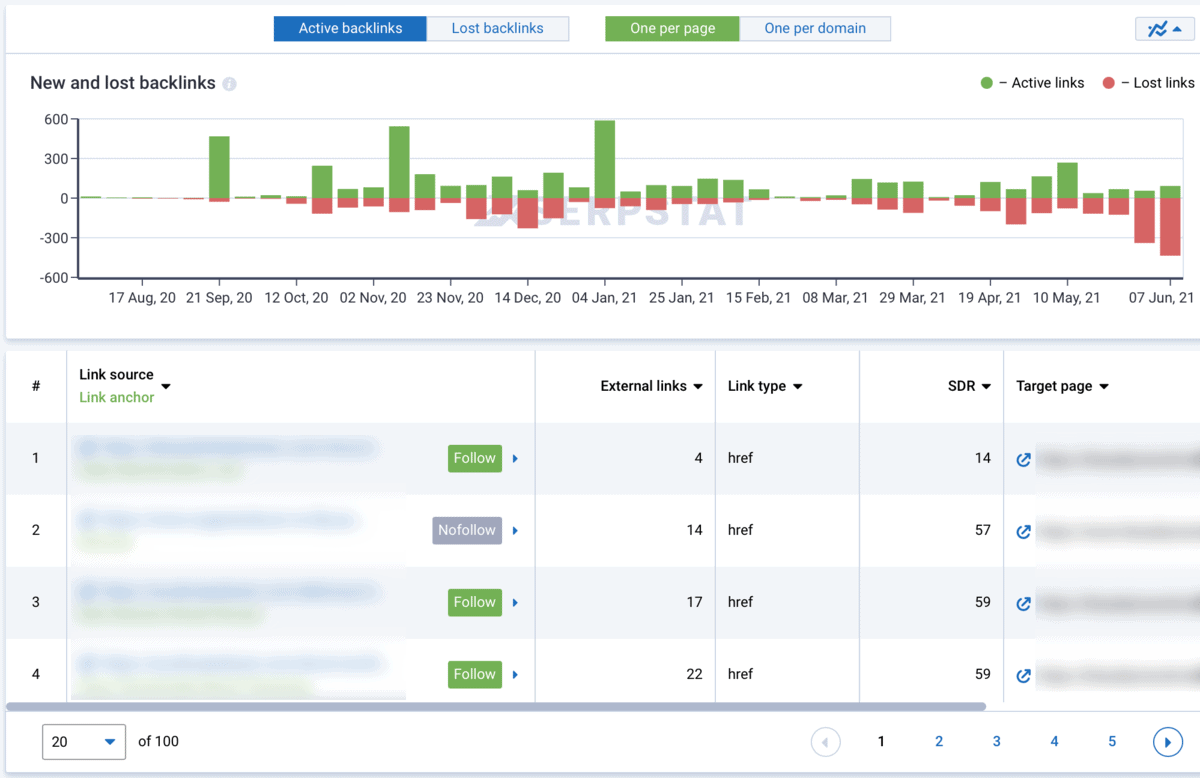
Looking at your competitor’s backlinks are useful for a handful of reasons:
- Find potential link sources – To get results with link building, you need to find the right link sources. What better way to do this than to target websites that already link to your top competitor?
- Claim their lost links – Sometimes, competitors lose backlinks because of errors, updated content, or a changed URL. You can tell the referring domain about the broken link and politely ask them to point to you instead.
- Spy on their content strategy – On the backlinks page, Serpstat also shows the target URL for each link. This will give you insights on the competitor’s content strategy so you can create your own link-worthy assets.
- Identify their keywords – Underneath each link, you’ll find the exact anchor text used by the referring domain. More often than not, you’ll find potential keywords that can bring quality traffic to your blog.
Looking at lost backlinks
By the way, you can focus exclusively on lost backlinks by simply clicking ‘Lost backlinks.’

You should find this extra useful in case you’re in the mood to steal some backlinks. Naturally, you can also go here to reclaim links you’ve lost yourself.
Here’s a guide that can help you with proven link-building strategies, including link reclamation.
Spying on your competitor’s content
Apart from running a backlink analysis, there’s another way to steal content ideas from your competitors.
Again, after entering your competitor’s domain, click ‘Top pages’ under the “Backlink analysis” sub-menu.
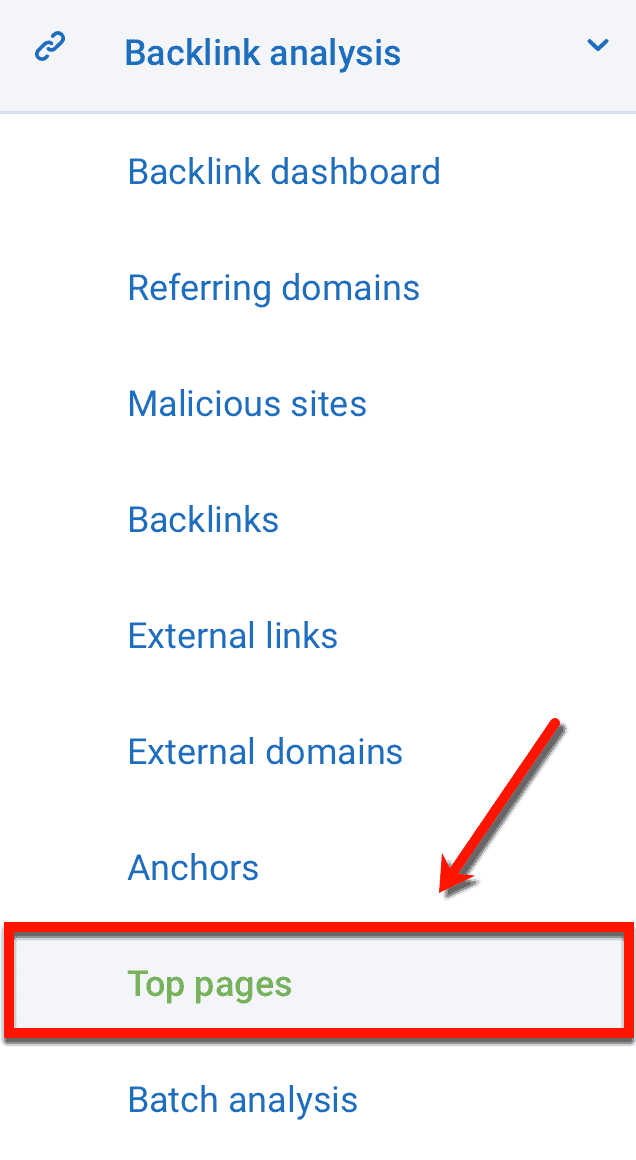
You’ll love this.
On the main window, you’ll find a list of your competitor’s best content.

The list can be sorted according to the number of referring domains, total backlinks, or referring IPs.
These metrics are good indications of the content’s link-worthiness.
Analyzing specific pages
You can also individually analyze each page by clicking on their URL.
Doing so will reveal additional data, like the page’s SERP positions and the keyword’s search volume.

Serpstat also throws in a bunch of additional keyword ideas under “Missing keywords.”
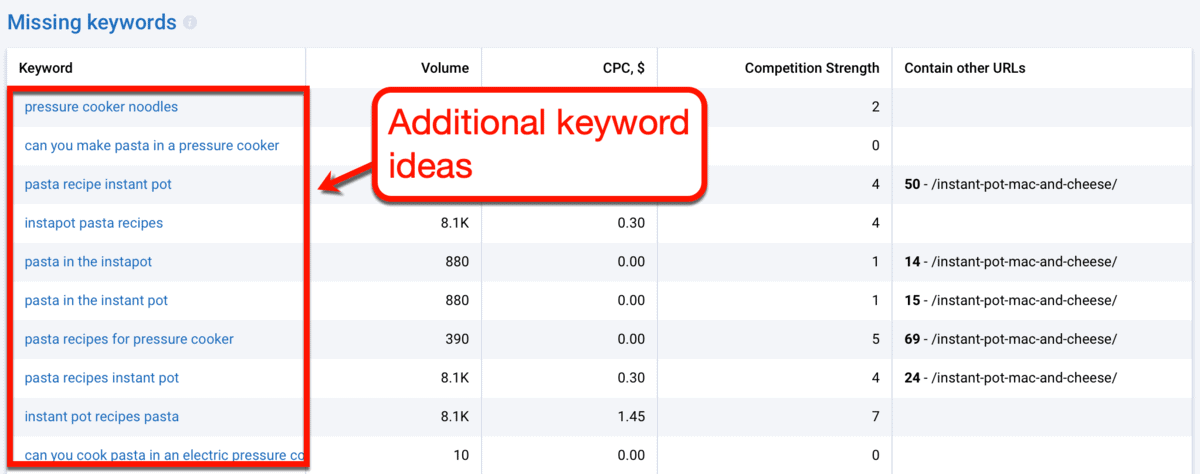
These are relevant keywords that your competitor’s website ranks for, but not the analyzed page.
As such, consider targeting these keywords when “borrowing” ideas from their content. This will help you create an outstanding piece that will outrank them.
Check your competitor’s traffic, keyword count, and Facebook shares
To reveal other competitor content data, run a domain analysis instead and look at ‘Top pages’ under “SEO research.”
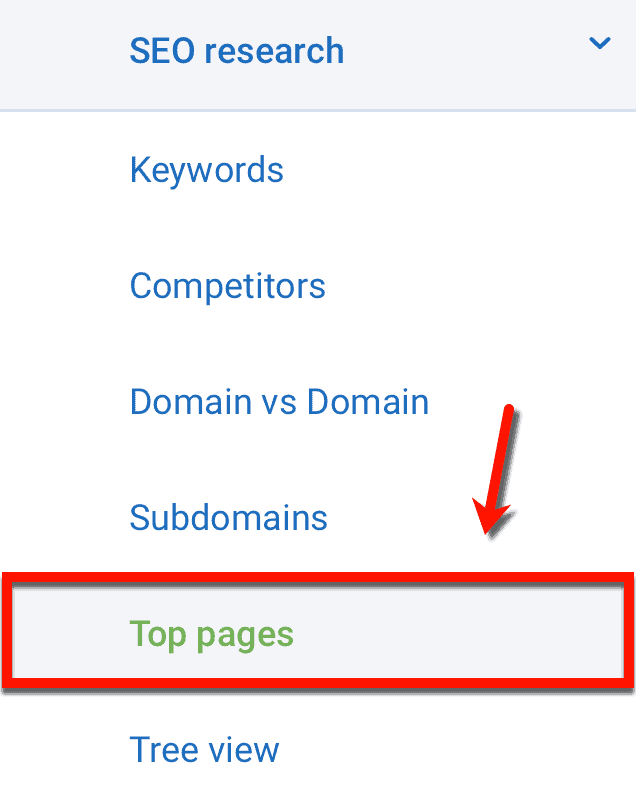
Unlike the previous tool, this one will reveal performance metrics like the page’s organic keywords, traffic, and Facebook shares.
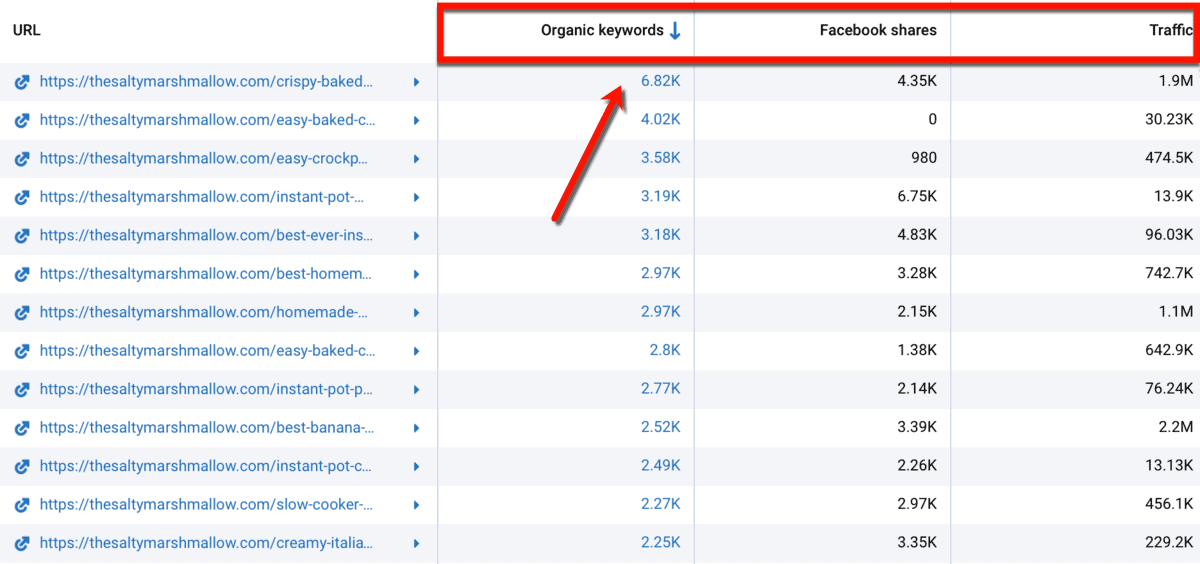
To be perfectly honest, I wish these metrics were also covered by the backlink analysis tool.
They would’ve been incredibly helpful when deciding which link-worthy assets are worth creating. But then again, maybe you only want to look for ideas that are highly effective in generating backlinks.
Finally, we can’t keep ignoring Serpstat’s keyword research features.
Looking for profitable keyword ideas with Serpstat
When spying on your competitor’s content, you shouldn’t forget about their keywords.
You can take a quick look at them by clicking the number of keywords under the “Organic keywords” column.
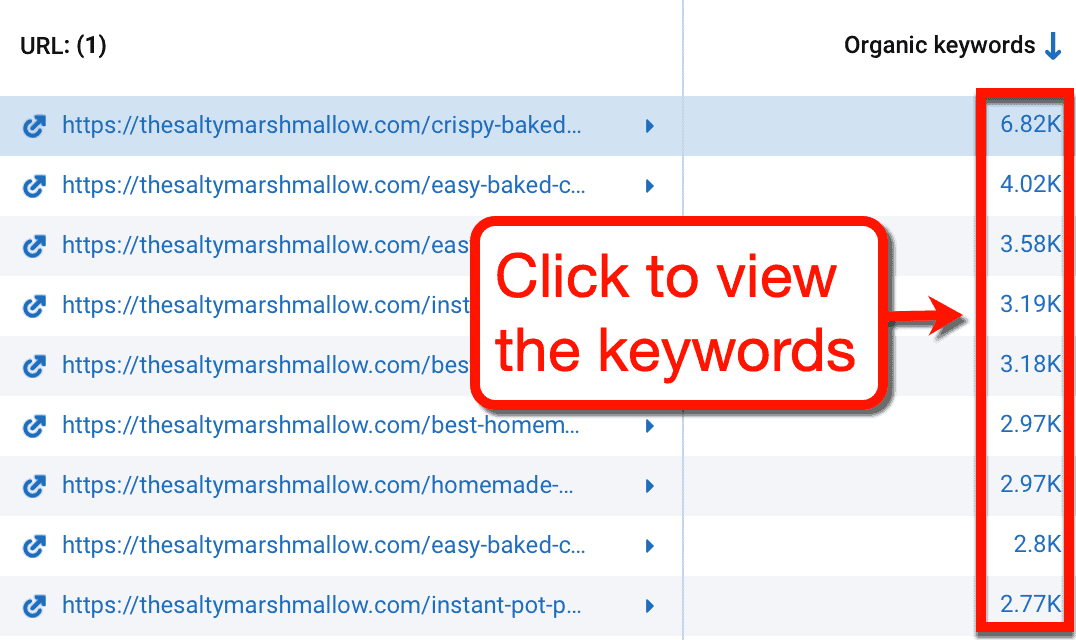
This will fire up Serpstat’s powerful and efficient keyword research tool.
Just like a top-tier tool, it can show you important keyword metrics like:
- Keyword difficulty rating
- The analyzed page’s estimated traffic from that keyword
- The analyzed page’s keyword position
- Average keyword Cost-Per-Click (CPC)
- Keyword search volume

Determining SERP features
Serpstat also detects the “SERP features” that each keyword triggers.
These are elements shown in search engine results that utilize markup data from web content.
Put simply, this is a SERP feature called the “People Also Ask Box”:
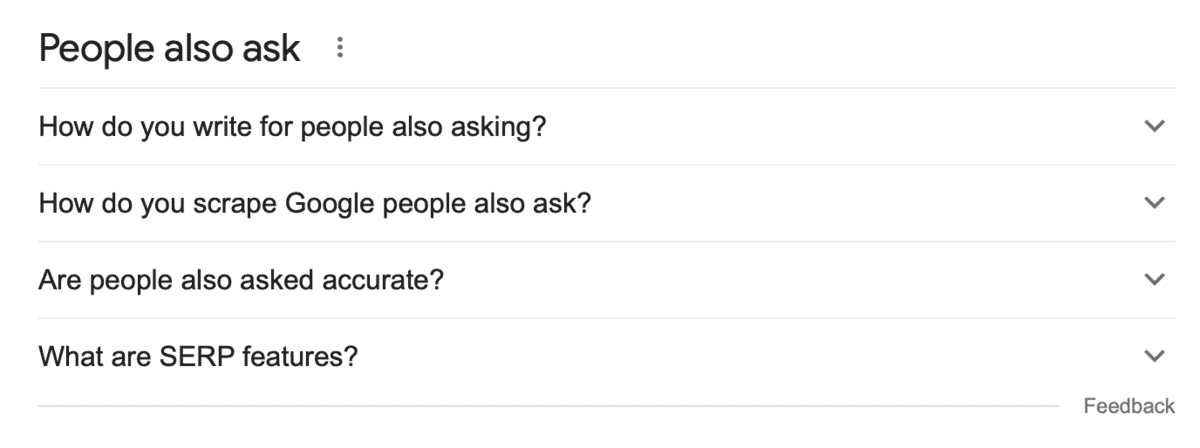
You can identify which SERP features are triggered by looking at the icons next to each keyword.

How does this help?
Think of SERP features as a way to bypass the number one position in Google.
Since they’re more eye-catching than a regular search result, they are very effective in generating clicks.
By looking at a keyword’s SERP features, you can optimize your content for those features using the right strategies.
Looking for long-tail keywords
Okay – enough about your competitor’s keywords.
What if you want to do keyword research from scratch?
First, you need to select ‘Keyword’ from the drop-down menu next to the search bar.
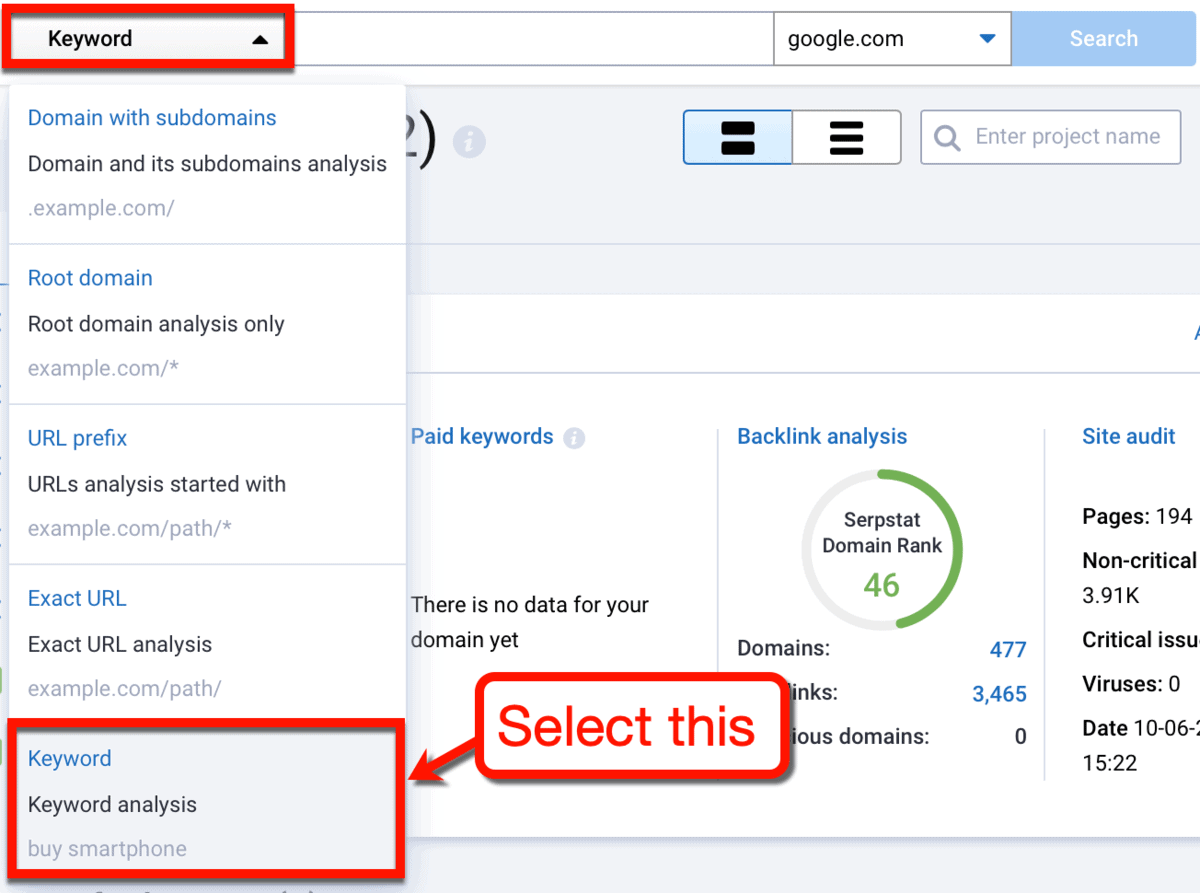
If you can’t find this option, go to your projects page and try again.
With “Keyword” selected, simply type in a seed keyword
This can be any vague term, like “soul food” or “vegetarian recipes.”

Within seconds, Serpstat will take you to an overview page with basic metrics on your seed keyword.
This includes the keyword’s average monthly search volume, PPC competitiveness, average CPC, and keyword difficulty rating.

These cool and all, but we’re not after them.
What we want are the keyword suggestions just below these numbers.
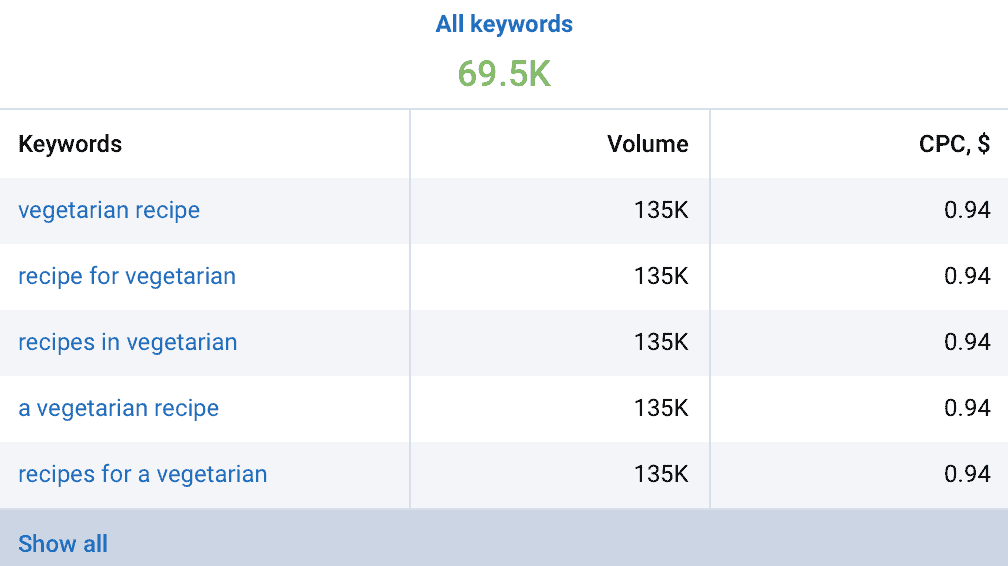
Right off the bat, Serpstat will suggest a few long-tail keywords based on your seed keyword. But that’s nowhere near enough.
For an even bigger list of keywords, click ‘Show all.’
This will present you with a full list of keyword ideas along with all the important metrics.
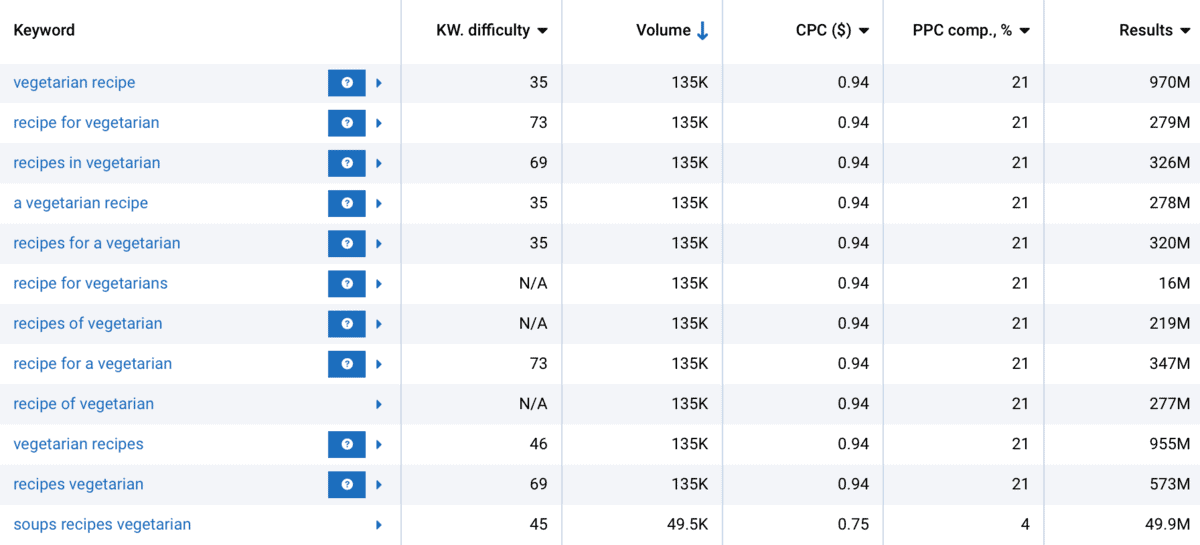
Using keyword filters
Having trouble looking for viable keyword ideas?
To refine your keywords list, use the filter option found above the list.
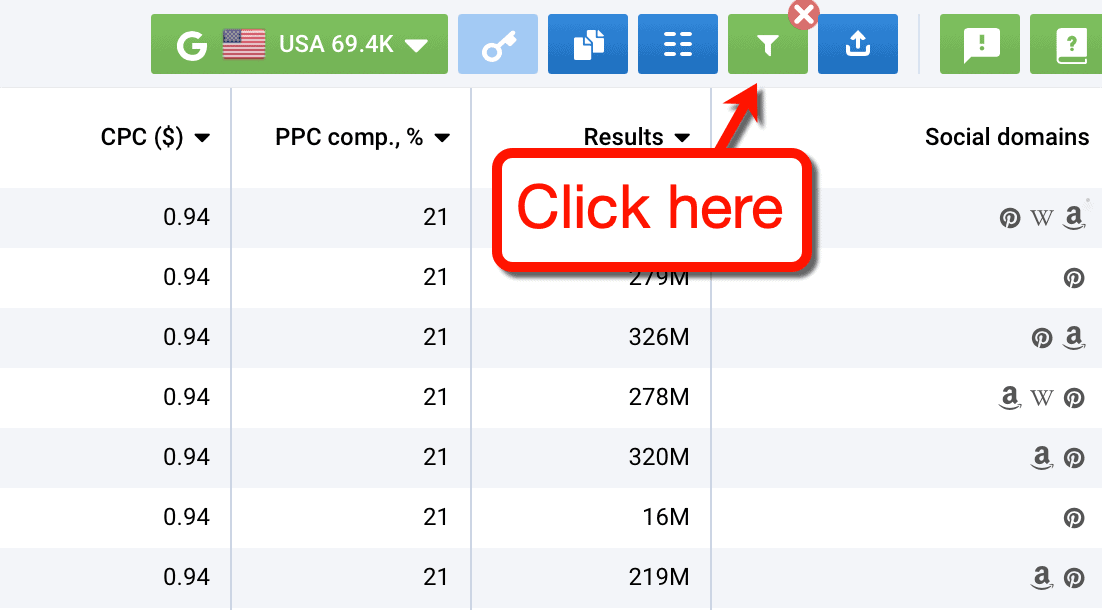
Filters make it easier for you to spot profitable keyword suggestions.
For example, if you want low-medium competition keywords, create a filter using “KW difficulty” as your parameter. Then, set the filter to get keywords with a difficulty rating of 0-40 (low-medium competition range).

To further filter your keywords, remember that you can always add additional parameters. Just choose the appropriate button depending on how you want filters to interact with each other.

Other than keyword difficulty, you can also filter keywords using these parameters:
- Volume
- CPC
- Number of results
- PPC competitiveness
- Number of words
- SERP features
- Misspelled keywords
- Toponyms
Building your keywords list
Found a few juicy keyword opportunities to target?
Use the checkboxes to the left to select them.

From there, you can choose between the following operations:
- Export keywords – Save and download your keywords list or send them over to Google Sheets.
- Add them to the rank tracker – If you’re already ranking for these keywords, add them to the rank tracker in one click.
- Submit keywords to batch analysis – Serpstat features a flexible keyword batch analysis feature that lets you manage your keywords list right on the platform.
Assessing your competitors for your target keyword
Going back to the keyword overview page, there are still a few things worth looking at.
Directly below the keyword suggestions, Serpstat allows you to take a peek at the competition.
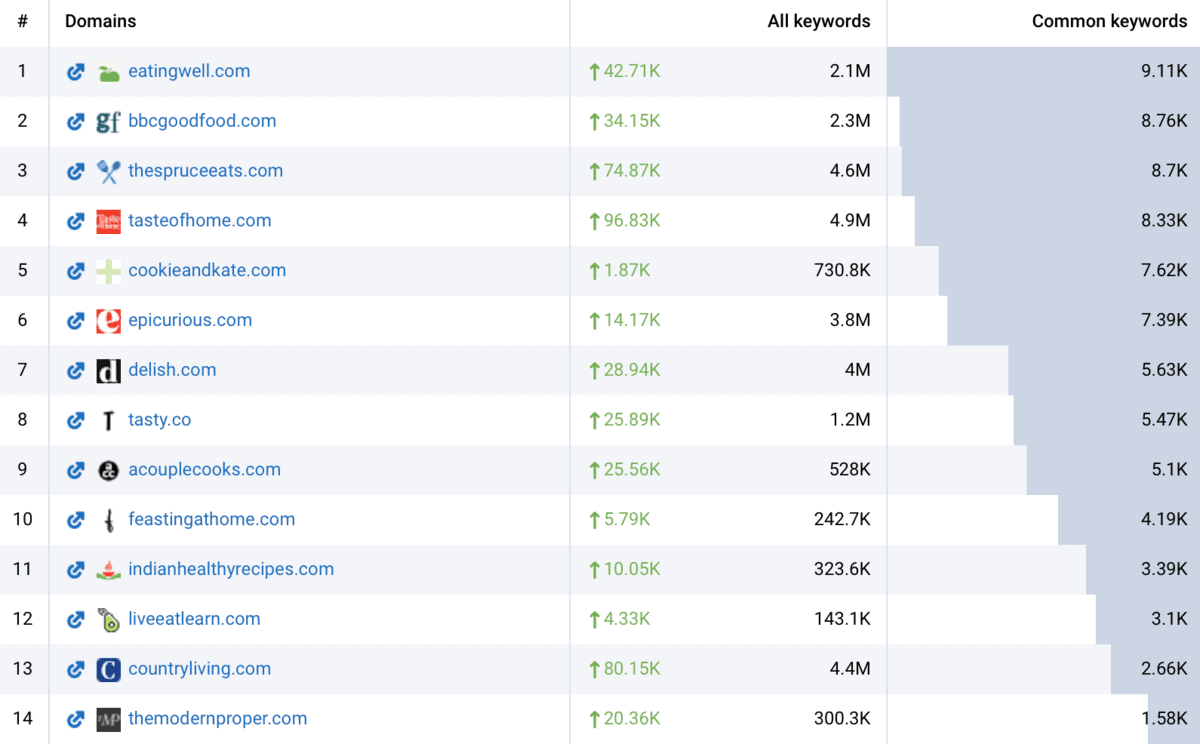
You can take advantage of this list to figure out what kind of content would rank well for your keyword. At the same time, you can analyze your competitors’ domains for information like their other keywords and link sources.
If you run a PPC campaign, you can also check out ad examples that the top brands use for your keyword.
You can find them at the very bottom of the keyword overview page.

Making the most out of Serpstat: Other helpful tools
That’s it – all the handy Serpstat features that most bloggers will find useful.
To make this the only Serpstat review you’ll ever need, let’s talk about other stuff under the hood.
Domain vs Domain
Under the SEO research menu, you can find a little something called “Domain vs Domain.”
Here, you can compare up to three competitors – checking their shared keywords, rankings, unique keywords, and so on.

Just one tiny hiccup: make sure you enter domains without “www.”

Otherwise, Serpstat will tell you that they couldn’t find any data for the entered domains. It’s a minor inconvenience, but I’m genuinely hoping they improve this in a future update.
Links intersect
While the previous tool compares your competitors’ keywords, the “Links intersect” feature compares their link sources. Use it to analyze their backlink metrics and find common as well as unique link sources for each domain.
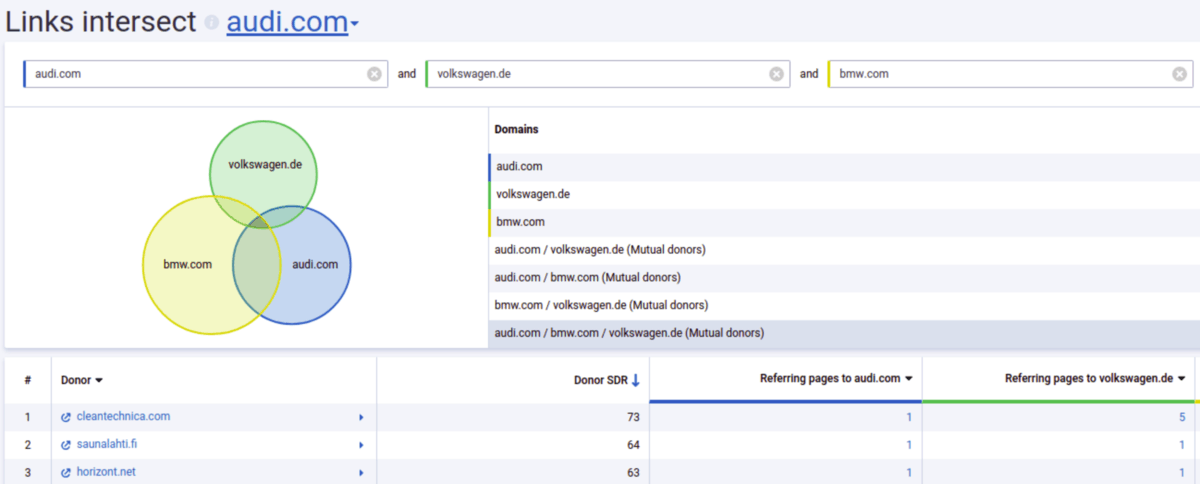
Of course, you can also use this tool to find competitor link sources that you’re missing. Simply use the tool while entering your own website in one of the domain fields.
Task lists
If you’re new to SEO, Serpstat can hold your hand through each step with its “Task lists” feature.
Task lists are basically templates that will tell you exactly what you need to do when using the platform. It includes a detailed step-by-step guide that ultimately makes the experience as beginner-friendly as possible.
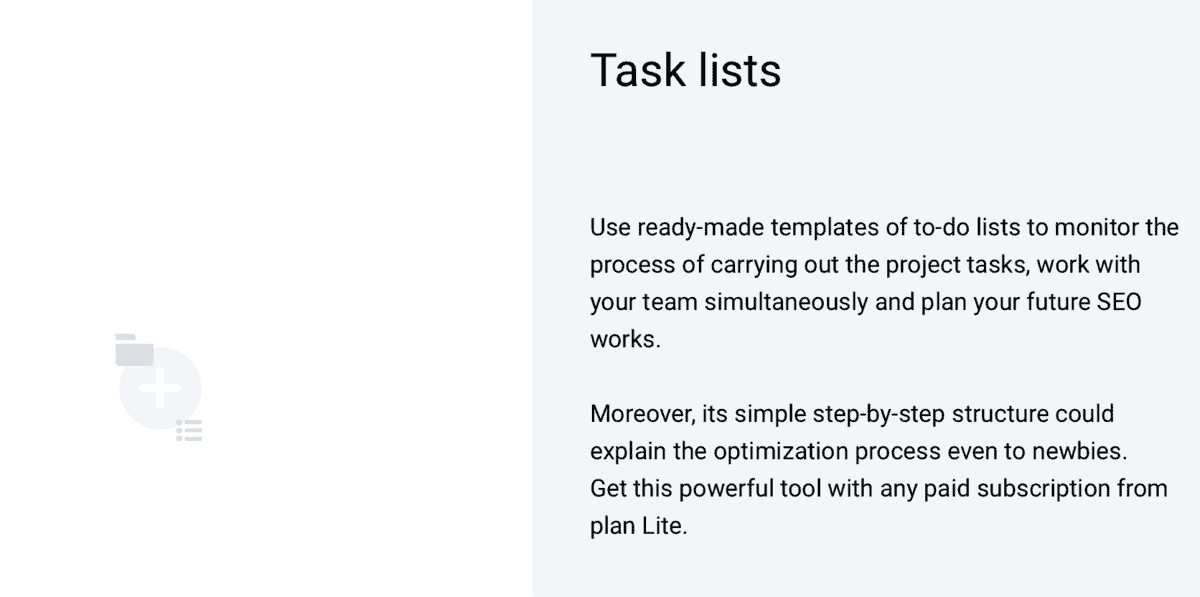
Custom reports
Offering SEO services on the side?
With Serpstat’s “Custom reports” tool, you can fully customize the dashboard page for a specific domain or existing project.
Setting up the report is as easy as selecting the data sections you want to show. You can also reposition these sections, add text, and export the report as a PDF file.

Additional tools
By now, we’ve covered almost everything Serpstat has to offer.
Before we wrap up this review, here are a few more Serpstat features you may find interesting:
- Malicious sites – Keeping a healthy backlink profile means removing links from spammy websites. Serpstat makes this task a breeze by automatically generating a list of malicious websites that Google already blacklisted.
- Ads landing pages – Spying on your competitor’s ad landing pages will give you an even clearer view of their strategy. Use this to adopt proven PPC strategies that your competitors worked hard to plan.
- Database storm – Serpstat’s “Database storm” feature visualizes the level of activity in search engine rankings over the last 30 days. A high “storm rate” indicates a lot of rank changes within 24 hours, be it on Google or Yandex.
- Keywords quality control – The “Keywords quality control” tool automatically weeds out keywords that aren’t included in Yandex’s database. Unfortunately, the tool currently can’t help you if you’re targeting organic traffic from Google.
- Keyword clustering and text analysis – Keyword clustering can organize massive lists of keywords by automatically grouping them according to semantic similarity. Text analysis, on the other hand, can help by providing on-page SEO suggestions.
Serpstat Pricing
Nice – you’ve made it to
Serpstat must have made a solid impression on you.
The question now is, how much does Serpstat cost?
Remember, you can get a 25 percent discount on any plan using the coupon code “MasterBlogging.” Cash in this exclusive offer on this page.
With that out of the way, let’s take a look at Serpstat’s pricing plans.
| Feature | Lite | Standard | Advanced | Enterprise |
| Price | $69 monthly, $55 monthly with annual billing | $149 monthly, $119 monthly with annual billing | $299 monthly, $239 monthly with annual billing | $499 monthly, $399 monthly with annual billing |
| Users | 1 | 3 | 5 | 7 |
| Keyword searches per day | 4,000 | 5,000 | 8,000 | 12,000 |
| Keyword results per report | 10,000 keywords | 30,000 keywords | 50,000 keywords | 75,000 keywords |
| Backlink searches per day | 500 | 1,000 | 1,500 | 2,000 |
| Backlink results per report | 5,000 backlinks | 25,000 backlinks | 30,000 backlinks | 50,000 backlinks |
| API access | Yes except for “Rank tracking” API | Yes | Yes | Yes |
| Branded and white label reports | No | Branded reports only | Branded reports only | Both |
I know, those prices can be a little steep, especially for new bloggers.
Just don’t forget – you can get a huge discount using the coupon code “MasterBlogging.”
Serpstat Frequently Asked Questions
What is Serpstat?
Serpstat is a “growth hacking” tool packed with features that can help with SEO, PPC, and content marketing. It can help you with keyword research, rank tracking, site auditing, competitor research, backlink analysis, and more.
Is Serpstat free?
No, but Serpstat offers a free version with limited daily searches and results. This allows you to see its features in action before you purchase a paid plan.
Who is Serpstat for?
Serpstat is one of the top SEO and PPC tools recommended for agencies, bloggers, small businesses, and online entrepreneurs. They offer flexible pricing plans that can fit users of all sizes.
Conclusion
Serpstat has everything you need to get measurable results in your SEO and PPC campaigns. It’s also incredibly easy to use even for beginners – thanks to the fast and user-friendly virtual interface.
It’s definitely not perfect. There are still a few things the Serpstat development team can improve to make the product absolutely stellar.
But in its current state, I’d still confidently recommend it to those who need a reliable, all-in-one digital marketing tool.
Again, remember that you can get a 25% discount on any Serpstat plan using the code “MasterBlogging.” Click here to get this exclusive deal.
For questions, suggestions, and general feedback, write a comment below. I also recommend checking out my other reviews to find the perfect SEO and PPC tool for you.
You Might Also Like:
- Semrush Review & Tutorial: Learn How to Use This SEO Tool
- Serpstat vs Semrush: The Ultimate SEO Tool Showdown
- Discover Other Awesome Blogging Resources Here (Must-Read!)


Post a Comment